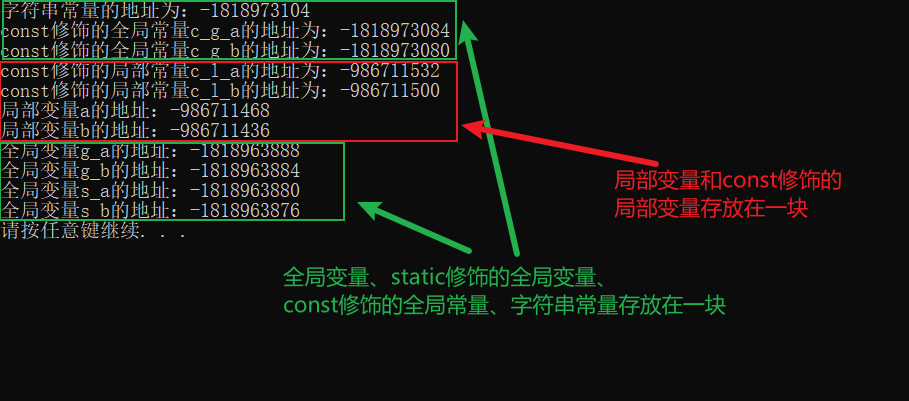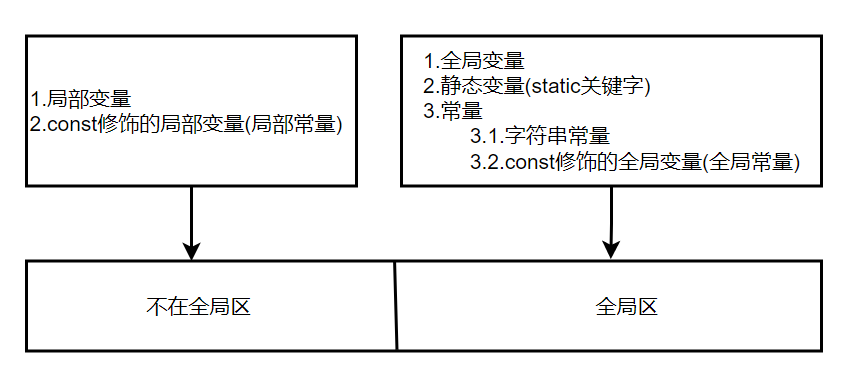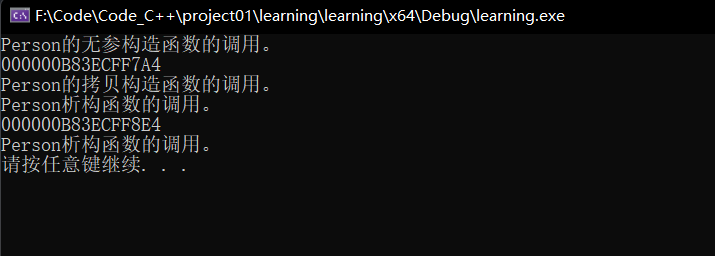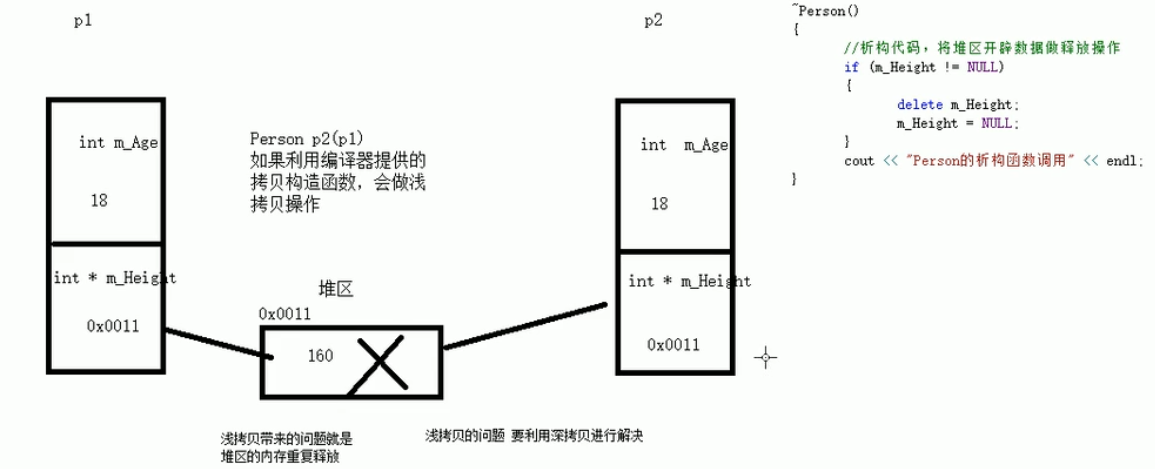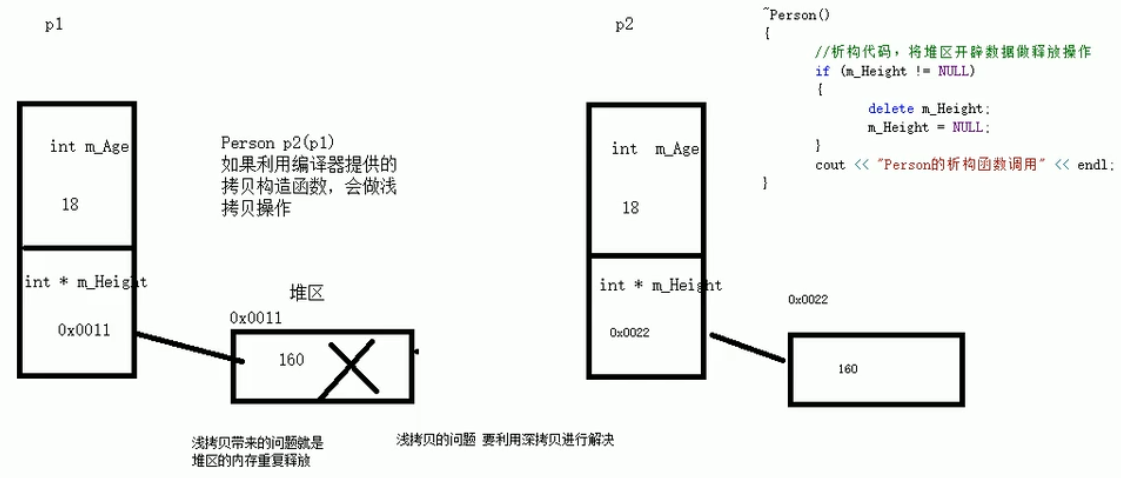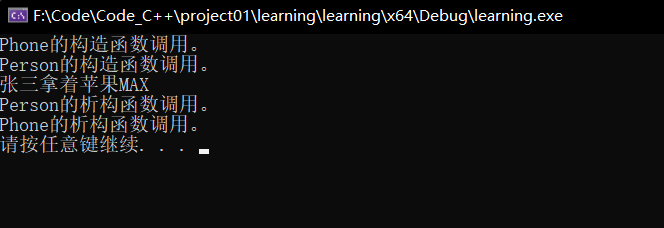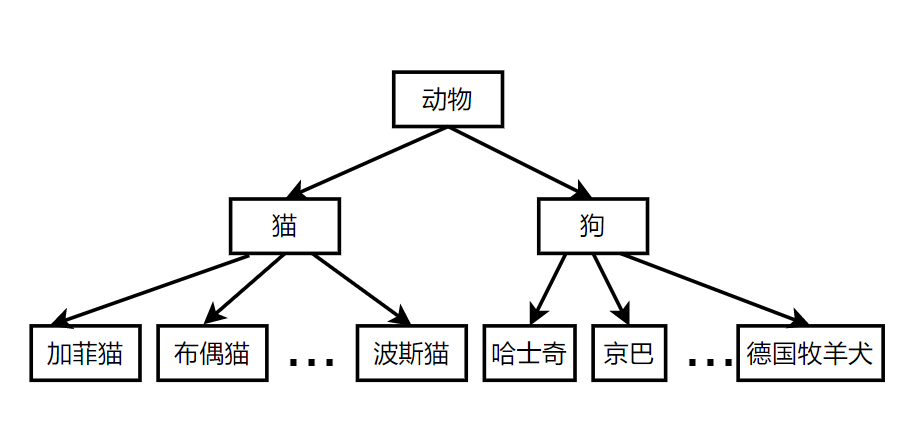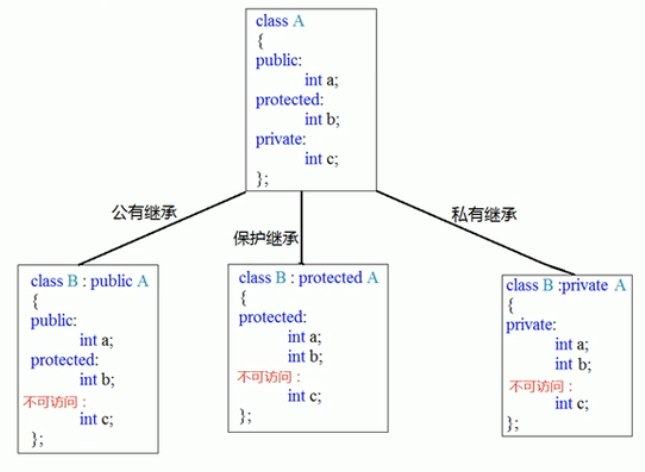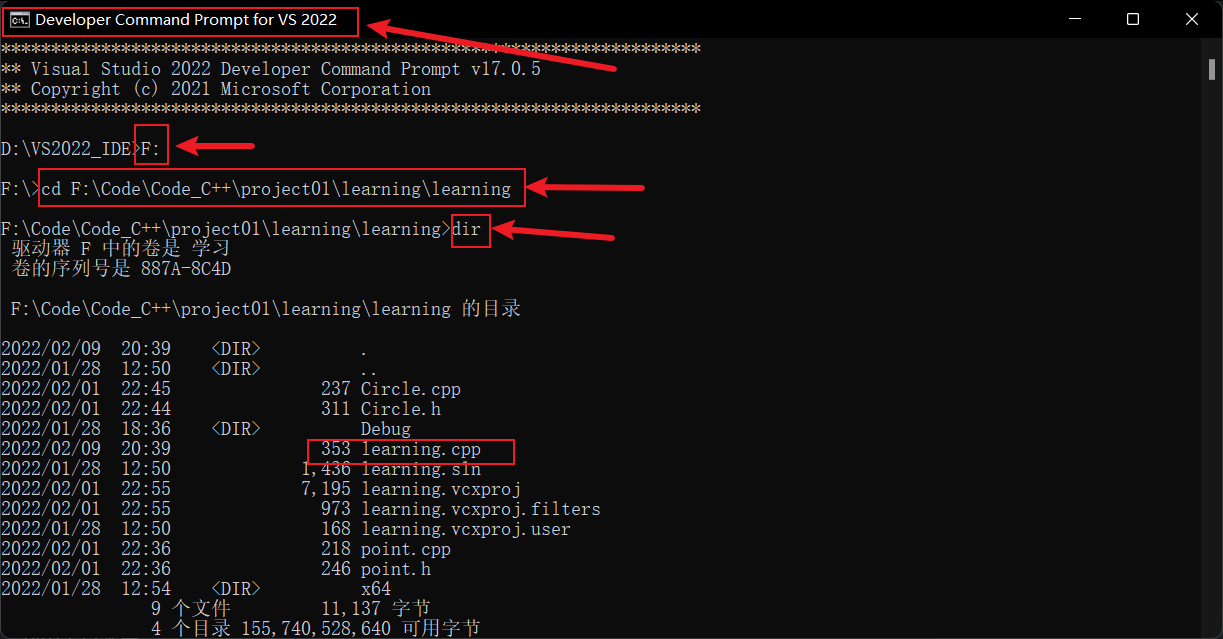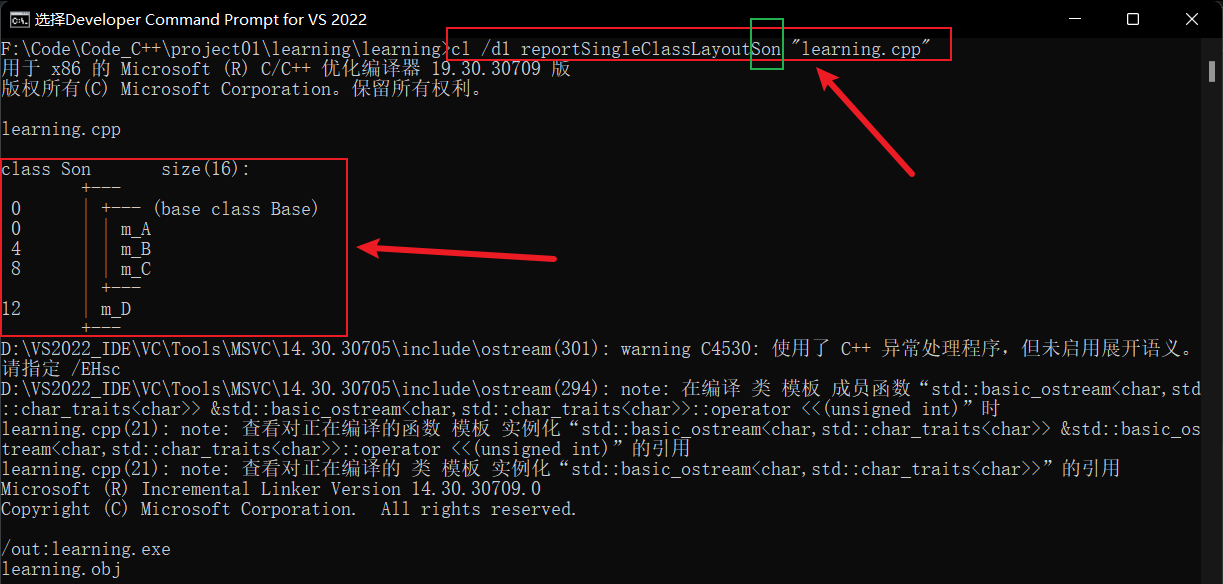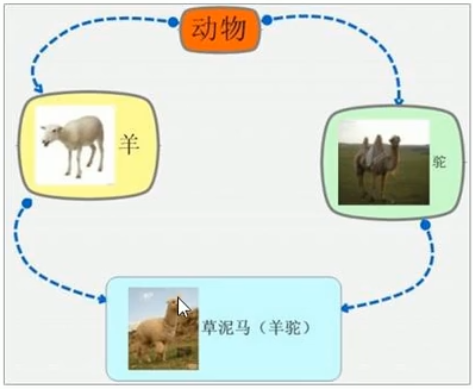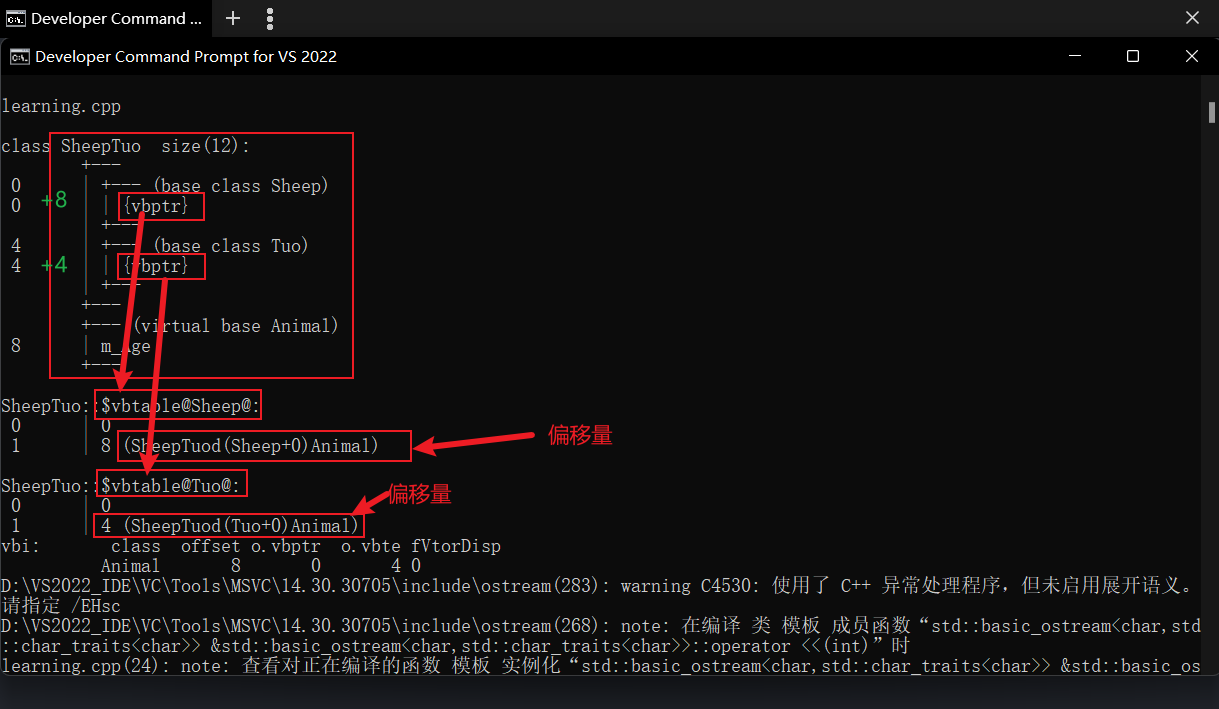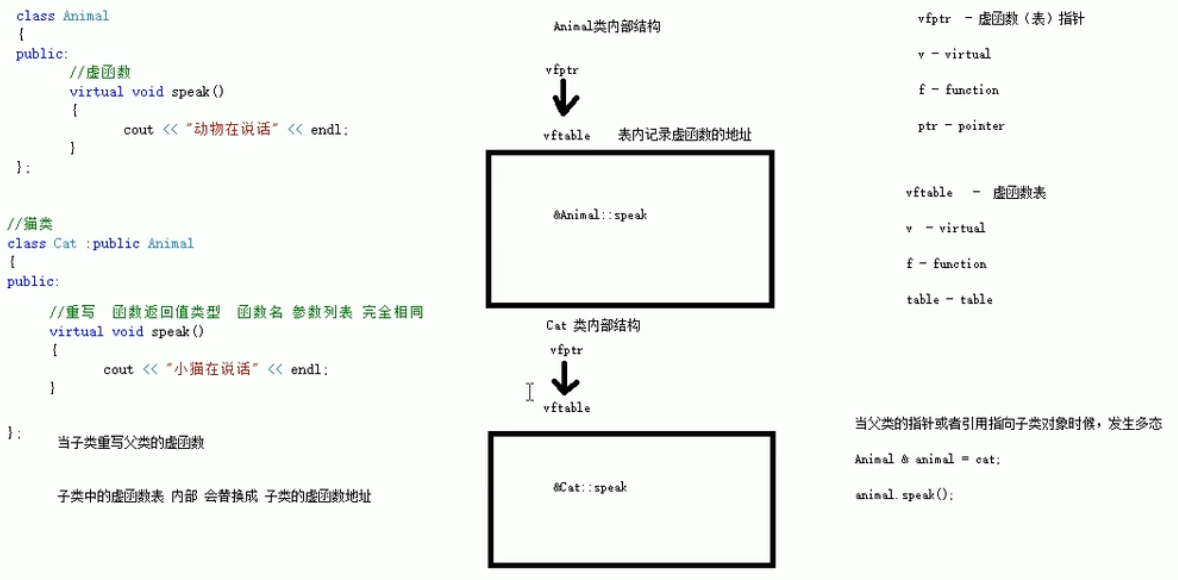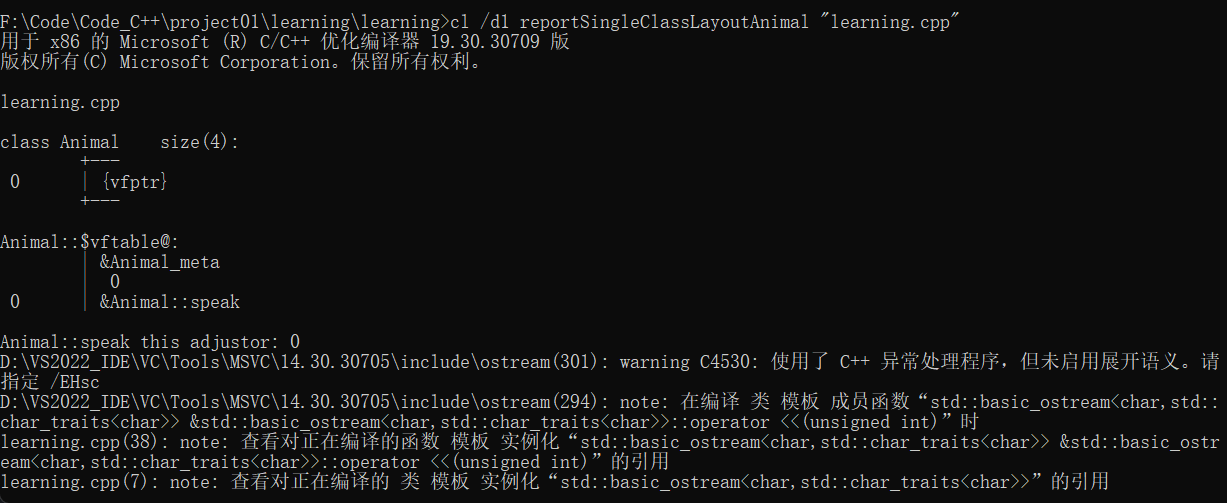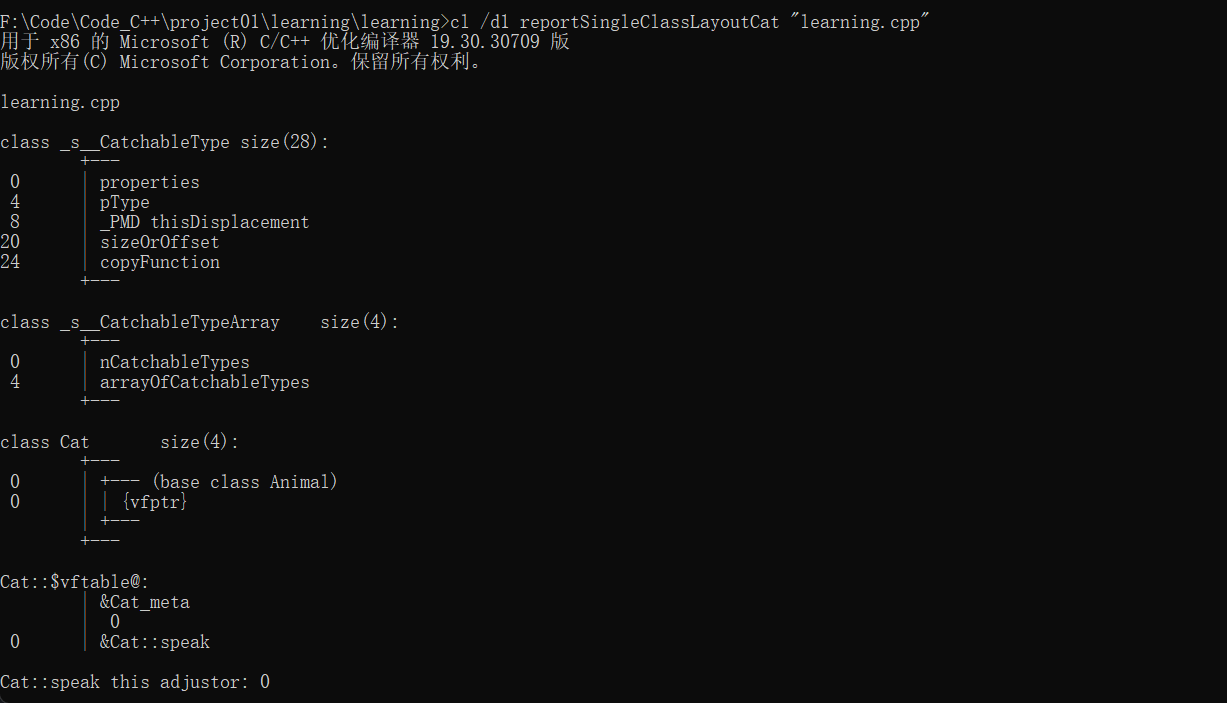本阶段主要针对C++面向对象编程技术做详细讲解,探讨C++中的核心和精髓。
1 内存分区模型
C++程序在执行时,将内存大方向分为4个区域 :
代码区:存放函数体的二进制代码,由操作系统进行管理;
全局区:存放全局变量和静态变量以及常量;
栈区:由编译器自动分配释放,存放函数的参数值,局部变量等;
堆区:由程序员分配和释放,若程序员不释放,程序结束时由操作系统回收。
在程序运行前有代码区和全局区,程序运行后才有栈区和堆区。
内存四区意义:
不同区域存放的数据,赋予不同的生命周期,给我们很大的灵活编程。
1.1 在程序运行前
在程序编译后,生成了exe可执行文件,未执行该程序前分为两个区域:
代码区 :
存放CPU执行的机器指令;
代码区时==共享 ==的,共享的目的是对于频繁被执行的程序,只需要在内存中由一份代码即可;
代码区是==只读 ==的,使其只读的原因是防止程序意外地修改了它的指令。
全局区 :
全局变量 和静态变量 存放在此;
全局区还包含了常量区 ,字符串常量 和其他常量(也包括const修饰的变量)也存放在此;
==该区域的数据在程序结束后由操作系统释放。==
总结:
不在全局区中 :局部变量、const修饰的局部变量
在全局区中:全局变量、静态变量(static关键字修饰的变量)、常量(字符串常量、const修饰的全局变量(全局常量))
例如:
1 2 3 4 5 6 7 8 9 10 11 12 13 14 15 16 17 18 19 20 21 22 23 24 25 26 27 28 29 30 31 32 33 34 35 36 37 38 39 40 41 42 43 44 45 46 #include <iostream> using namespace std;int g_a = 10 ;int g_b = 10 ;const int c_g_a = 10 ;const int c_g_b = 10 ;int main () static int s_a = 10 ; static int s_b = 10 ; cout << "字符串常量的地址为:" << (int )&"hello world" << endl; cout << "const修饰的全局常量c_g_a的地址为:" << (int )&c_g_a << endl; cout << "const修饰的全局常量c_g_b的地址为:" << (int )&c_g_b << endl; const int c_l_a = 10 ; const int c_l_b = 10 ; cout << "const修饰的局部常量c_l_a的地址为:" << (int )&c_l_a << endl; cout << "const修饰的局部常量c_l_b的地址为:" << (int )&c_l_b << endl; int a = 10 ; int b = 10 ; cout << "局部变量a的地址:" << (int )&a << endl; cout << "局部变量b的地址:" << (int )&b << endl; cout << "全局变量g_a的地址:" << (int )&g_a << endl; cout << "全局变量g_b的地址:" << (int )&g_b << endl; cout << "全局变量s_a的地址:" << (int )&s_a << endl; cout << "全局变量s_b的地址:" << (int )&s_b << endl; system ("pause" ); return 0 ; }
运行结果:
总结:
C++中在程序运行前分为全局区和代码区;
代码区特点是共享和只读;
全局区中存放全局变量、静态变量、常量;
常量区存放const修饰的全局变量(也称全局常量)和字符串常量。
1.2 程序运行后
栈区 :
由编译器自动分配释放,存放函数的参数值,局部变量等。
注意事项:==不要返回局部变量的地址==,栈区开辟的数据由编译器自动释放。
==错误示例==:下面程序中返回局部变量的地址是错误的,栈区的数据运行后会自动释放。
1 2 3 4 5 6 7 8 9 10 11 12 13 14 15 16 17 18 19 #include <iostream> using namespace std;int * func (int b) b = 100 ; int a = 10 ; return &a; } int main () int * p = func (1 ); cout << *p << endl; cout << *p << endl; system ("pause" ); return 0 ; }
堆区 :
由程序员分配释放,若程序员不释放,程序结束时由操作系统回收
在C++中主要利用new在堆区开辟内存
示例:
1 2 3 4 5 6 7 8 9 10 11 12 13 14 15 16 17 #include <iostream> using namespace std;int * func () int * p = new int (10 ); return p; } int main () int * p = func (); cout << *p << endl; system ("pause" ); return 0 ; }
总结:
堆区数据由程序员管理开辟和释放。
堆区数据利用new关键字进行开辟内存
1.3 new操作符
C++中利用==new==操作符在堆区开辟数据
堆区开辟的数据,由程序员手动开辟,手动释放,释放利用操作符==delete==
语法 :new 数据类型
==利用new创建的数据,会返回该数据对应的类型的指针。==
示例:基本语法
1 2 3 4 5 6 7 8 9 10 11 12 13 14 15 16 17 18 19 20 21 22 23 24 25 26 27 28 29 30 31 32 33 34 35 36 37 38 39 #include <iostream> using namespace std;int * func () int * p = new int (10 ); return p; } void test01 () int * p = func (); cout << *p << endl; delete p; } void test02 () int * arr = new int [10 ]; for (int i = 0 ; i < 10 ; i++) { arr[i] = i + 100 ; } for (int i = 0 ; i < 10 ; i++) { cout << arr[i] << endl; } delete [] arr; } int main () test01 (); test02 (); system ("pause" ); return 0 ; }
2 引用
2.1 引用的基本操作
作用 :给变量起别名
语法 :数据类型 &别名 = 原名
示例:
1 2 3 4 5 6 7 8 9 10 11 12 13 14 15 16 17 18 #include <iostream> using namespace std;int main () int a = 10 ; int & b = a; cout << "a = " << a << endl; cout << "b = " << b << endl; b = 100 ; cout << "a = " << a << endl; cout << "b = " << b << endl; system ("pause" ); return 0 ; }
2.2 引用注意事项
示例:
1 2 3 4 5 6 7 8 9 10 11 12 13 14 15 16 17 18 19 20 21 22 23 24 25 26 #include <iostream> using namespace std;int main () int a = 10 ; int c = 20 ; int & b = a; b = c; cout << "a = " << a << endl; cout << "b = " << b << endl; cout << "c = " << c << endl; b = 100 ; cout << "a = " << a << endl; cout << "b = " << b << endl; cout << "c = " << c << endl; system ("pause" ); return 0 ; }
2.3 引用做函数参数
作用 :函数传参时,可以利用引用的技术让形参修饰实参
优点 :可以简化指针修改实参
示例:
1 2 3 4 5 6 7 8 9 10 11 12 13 14 15 16 17 18 19 20 21 22 23 24 25 26 27 28 29 30 31 32 33 34 35 36 37 38 39 40 41 42 43 44 45 46 47 48 #include <iostream> using namespace std;void swap01 (int a, int b) int temp = a; a = b; b = temp; } void swap02 (int * a, int * b) int temp = *a; *a = *b; *b = temp; } void swap03 (int & a, int & b) int temp = a; a = b; b = temp; } int main () int a = 10 ; int b = 20 ; swap01 (a, b); cout << "swap01 a = " << a << endl; cout << "swap01 b = " << b << endl; a = 10 ; b = 20 ; swap02 (&a, &b); cout << "swap02 a = " << a << endl; cout << "swap02 b = " << b << endl; a = 10 ; b = 20 ; swap03 (a, b); cout << "swap03 a = " << a << endl; cout << "swap03 b = " << b << endl; system ("pause" ); return 0 ; }
总结:通过引用参数产生的效果同按地址传递是一样的。引用的语法更加清楚简单。
2.4 引用做函数返回值
作用 :引用是可以作为函数的返回值存在的。
注意:不要返回局部变量引用
用法:函数调用作为左值
示例:
1 2 3 4 5 6 7 8 9 10 11 12 13 14 15 16 17 18 19 20 21 22 23 24 25 26 27 28 29 30 #include <iostream> using namespace std;int & test01 () int a = 10 ; return a; } int & test02 () static int a = 10 ; return a; } int main () int & ref2 = test02 (); cout << "ref2 = " << ref2 << endl; test02 () = 1000 ; cout << "ref2 = " << ref2 << endl; system ("pause" ); return 0 ; }
2.5 引用的本质
本质:引用的本质在C++内部实现是一个指针常量。
讲解示例:
1 2 3 4 5 6 7 8 9 10 11 12 13 14 15 16 17 18 19 20 21 22 23 24 #include <iostream> using namespace std;void func (int & ref) ref = 100 ; } int main () int a = 20 ; int & ref = a; ref = 20 ; cout << "a:" << a << endl; cout << "ref2:" << ref << endl; func (a); cout << "a:" << a << endl; cout << "ref2:" << ref << endl; system ("pause" ); return 0 ; }
总结:C++推荐用引用技术,因为语法方便,引用本质是指针常量,但是所有的指针操作编译器都帮我们做了。
2.6 常量引用
作用 :常量引用主要用来修饰形参,防止误操作
在函数形参列表中,可以加const修饰形参,防止形参改变实参
示例1:
1 2 3 4 5 6 7 8 9 10 11 12 13 14 15 #include <iostream> using namespace std;int main () int a = 10 ; const int & ref = 10 ; cout << "a:" << a << endl; cout << "ref:" << ref << endl; system ("pause" ); return 0 ; }
示例2:
1 2 3 4 5 6 7 8 9 10 11 12 13 14 15 #include <iostream> using namespace std;void showValue (const int & ref) cout << "value:" << ref << endl; } int main () int a = 100 ; showValue (a); system ("pause" ); return 0 ; }
3 函数提高
3.1 函数默认参数
在C++中,函数的形参列表中的形参是可以有默认值的。
语法:返回值类型 函数名 (参数 = 默认值) {}
示例:
1 2 3 4 5 6 7 8 9 10 11 12 13 14 15 16 17 18 19 20 21 22 23 24 25 26 27 28 29 #include <iostream> using namespace std;int func (int a, int b = 20 , int c = 30 ) return a + b + c; } int func2 (int a = 10 , int b = 10 ) int main () int a = 100 ; cout << func (10 ) << endl; cout << func (10 , 30 ) << endl; cout << func2 () << endl; system ("pause" ); return 0 ; } int func2 (int a, int b) return a + b; }
总结:
如果函数实现中某个位置已经有了默认参数,那么从这个位置往后,从左到右都必须有默认值;
如果函数实现中已经定义了默认参数的值,如果主函数中如果调用这个函数,则用传过去的值进行函数运算;
如果函数的声明有默认参数,函数实现就不能有默认参数。==函数声明和函数实现只能有一个有运行参数==。
3.2 函数占位参数
C++中函数的形参列表里可以有占位参数,用来做占位,==调用函数时必须填补该位置==。
语法 :返回值类型 函数名 (数据类型) {}
在现阶段函数的占位参数存在意义不大,但是后面的课程中会用到该技术。
示例:
1 2 3 4 5 6 7 8 9 10 11 12 13 14 15 16 #include <iostream> using namespace std;void func (int a,int ) cout << "This is function." << endl; } int main () int a = 100 ; func (a,10 ); system ("pause" ); return 0 ; }
3.3 函数重载
3.3.1 函数重载概述
作用 :函数名可以相同,提高复用性
函数重载满足条件 :
同一个作用域下
函数名称相同
函数参数类型不同 或者个数不同 或者顺序不同
注意 :函数的返回值不可以作为函数重载的条件
示例:
1 2 3 4 5 6 7 8 9 10 11 12 13 14 15 16 17 18 19 20 21 22 23 24 25 26 27 28 29 30 31 32 33 34 35 36 37 38 39 40 41 #include <iostream> using namespace std;void func () cout << "func 的调用" << endl; } void func (int a) cout << "func(int a) 的调用" << endl; } void func (double a) cout << "func(double a) 的调用" << endl; } void func (int a, double b) cout << "func(int a, double b) 的调用" << endl; } void func (double a, int b) cout << "func(double a, int b) 的调用" << endl; } int main () func (); func (10 ); func (3.14 ); func (10 , 3.14 ); func (3.14 ,10 ); system ("pause" ); return 0 ; }
3.3.2 函数重载注意事项
示例:
1 2 3 4 5 6 7 8 9 10 11 12 13 14 15 16 17 18 19 20 21 22 23 24 25 26 27 28 29 30 31 32 #include <iostream> using namespace std;void func (int & a) cout << "func(int& a) 的调用" << endl; } void func (const int & a) cout << "func(const int& a) 的调用" << endl; } void func2 (int a,int b = 10 ) cout << "func(int a,int b = 10) 的调用" << endl; } void func2 (int a) cout << "func(int a) 的调用" << endl; } int main () int a = 10 ; func (a); func (10 ); func2 (10 , 20 ); system ("pause" ); return 0 ; }
4 类和对象
C++面向对象的三大特征:==封装、继承、多态==
C++认为万事万物都皆为对象,对象上有其属性和行为
例如:
人可以作为对象,属性有姓名、年龄、身高、体重…,行为有走、跑、跳、吃饭、唱歌…
车也可以作为对象,属性有轮胎、方向盘、车灯…,行为有载人、放音乐、放空调…
具有相同性质的==对象==,我们可以抽象成为==类==,人属于人类,车属于车类
4.1 封装
4.1.1 封装的意义
封装是C++面向对象三大特征之一
封装的意义:
将属性和行为作为一个整体,表现生活中的事物
将属性和行为加以权限控制
封装的意义一 :
在设计类的时候,属性和行为写在一起,表现事物
语法 :class 类名{ 访问权限: 属性 / 行为 }
示例1:设计一个圆类,求圆的周长
1 2 3 4 5 6 7 8 9 10 11 12 13 14 15 16 17 18 19 20 21 22 23 24 25 26 27 28 29 #include <iostream> using namespace std;const double pi = 3.14 ;class Circle { public : int m_r; double calculateZC () return 2 * pi * m_r; } }; int main () Circle c1; c1.m_r = 10 ; cout << "圆的周长为:" << c1.calculateZC () << endl; system ("pause" ); return 0 ; }
示例2:设计一个学生类,属性有姓名和学号,可以给姓名和学号赋值,可以显示学生的姓名和学号
1 2 3 4 5 6 7 8 9 10 11 12 13 14 15 16 17 18 19 20 21 22 23 24 25 26 27 28 29 30 31 32 33 34 35 36 37 38 39 40 41 #include <iostream> using namespace std;#include <string> class Student {public : string name; int number; void showStudent () cout << "学生的姓名:" << name << endl; cout << "学生的学号:" << number << endl; } void setStudent (string name1) name = name1; } void setnumber () cout << "请输入学号:" << endl; cin >> number; } }; int main () Student s1; s1.setStudent ("张三" ); s1.setnumber (); s1.showStudent (); Student s2; s2.setStudent ("李四" ); s2.setnumber (); s2.showStudent (); system ("pause" ); return 0 ; }
封装的意义二 :
类在设计时,可以把属性和行为放在不同的权限下,加以控制
访问权限有三种:
public 公共权限
protected 保护权限
private 私有权限
示例:
1 2 3 4 5 6 7 8 9 10 11 12 13 14 15 16 17 18 19 20 21 22 23 24 25 26 27 28 29 30 31 32 33 34 35 36 37 38 39 #include <iostream> using namespace std;#include <string> class person {public : string name; protected : string car; private : int password; public : void func () name = "张三" ; car = "拖拉机" ; password = 123456 ; } void output () cout << "输出所有信息:" << endl; cout << name << endl; cout << car << endl; cout << password << endl; } }; int main () person p1; p1.func (); p1.name = "李四" ; p1.output (); system ("pause" ); return 0 ; }
==总结==:
公共权限 public 成员 类内可以访问 类外可以访问
保护权限 protected 成员 类内可以访问 类外不可以访问 在继承中,儿子也可以访问父亲中的保护内容
私有权限 private 成员 类内可以访问 类外不可以访问 在继承中,儿子无法访问父亲中的私有内容
4.1.2 struct和class区别
在C++中struct和class唯一的区别就在于默认的访问权限不同
区别:
struct默认权限为公共
class默认权限为私有
1 2 3 4 5 6 7 8 9 10 11 12 13 14 15 16 17 18 19 20 21 #include <iostream> using namespace std;class C1 { int m_a; }; struct C2 { int m_a; }; int main () C1 c1; C2 c2; c2.m_a = 100 ; system ("pause" ); return 0 ; }
4.1.3 成员属性设置为私有
优点 :
将所有成员属性设置为私有,可以自己控制读写权限
对于写权限,我们可以检测数据的有效性
示例:
1 2 3 4 5 6 7 8 9 10 11 12 13 14 15 16 17 18 19 20 21 22 23 24 25 26 27 28 29 30 31 32 33 34 35 36 37 38 39 40 41 42 43 44 45 #include <iostream> using namespace std;#include <string> class Person { public : void setname (string name1) name = name1; } string getname () { return name; } int getage () return age; } void setlover (string lover1) lover = lover1; } void setage (int age1) if (age1 < 0 || age1>150 ) { age = 0 ; cout << "你这个老妖精!" << endl; return ; } age = age1; } private : string name; int age; string lover; }; int main () Person p; p.setname ("张三" ); cout << "姓名:" << p.getname () << endl; p.setage (10 ); cout << "年龄:" << p.getage () << endl; p.setlover ("Eureka" ); system ("pause" ); return 0 ; }
练习案例1:设计立方体类
设计立方体类(Cube)
求出立方体的面积和体积
分别用全局函数和成员函数判断两个立方体是否相等
1 2 3 4 5 6 7 8 9 10 11 12 13 14 15 16 17 18 19 20 21 22 23 24 25 26 27 28 29 30 31 32 33 34 35 36 37 38 39 40 41 42 43 44 45 46 47 48 49 50 51 52 53 54 55 56 57 58 59 60 61 62 63 64 65 66 67 68 69 70 71 72 73 74 75 76 77 78 79 80 81 82 83 84 85 86 87 88 89 90 91 92 93 94 #include <iostream> using namespace std;#include <string> class Cube {private : int m_L; int m_W; int m_H; public : void setL (int L) m_L = L; } int getL () return m_L; } void setW (int w) m_W = w; } int getW () return m_W; } void setH (int h) m_H = h; } int getH () return m_H; } int cals () return 2 * (m_H * m_L + m_H * m_W + m_L * m_W); } int calv () return m_H * m_L * m_W; } bool isSamebyclass ( Cube& c) if (c.getL () == m_L && c.getW () == m_W && c.getH () == m_H) { return true ; } return false ; } }; bool isSame (Cube& c1, Cube& c2) if (c1.getL () == c2.getL () && c1.getW () == c2.getW () && c1.getH () == c2.getH ()) { return true ; } return false ; } int main () Cube c1; c1.setL (10 ); c1.setW (10 ); c1.setH (10 ); cout << "c1的面积为:" << c1.cals () << endl; cout << "c1的体积为:" << c1.calv () << endl; Cube c2; c2.setL (10 ); c2.setW (10 ); c2.setH (10 ); cout << "c2的面积为:" << c2.cals () << endl; cout << "c2的体积为:" << c2.calv () << endl; bool ret = isSame (c1, c2); if (ret) { cout << "全局函数判断:c1和c2是相等的" << endl; } else { cout << "全局函数判断:c1和c2是不相等的" << endl; } bool ret2 = c2.isSamebyclass (c1); if (ret2) { cout << "By class: c1和c2是相等的" << endl; } else { cout << "By class:c1和c2是不相等的" << endl; } system ("pause" ); return 0 ; }
总结:成员函数传入一个未知的数据就可以了。
练习案例2:点和圆的关系
设计一个圆形类(Circle),和一个点类(Point),计算点和圆的关系。
整体写法:
1 2 3 4 5 6 7 8 9 10 11 12 13 14 15 16 17 18 19 20 21 22 23 24 25 26 27 28 29 30 31 32 33 34 35 36 37 38 39 40 41 42 43 44 45 46 47 48 49 50 51 52 53 54 55 56 57 58 59 60 61 62 63 64 65 66 67 68 69 70 71 72 73 74 75 76 77 78 79 80 81 82 83 84 85 86 87 #include <iostream> using namespace std;class Point {private : int m_X; int m_Y; public : void setX (int X) m_X = X; } int getX () return m_X; } void setY (int y) m_Y = y; } int getY () return m_Y; } }; class Circle {private : int m_R; Point m_Center; public : void setR (int r) m_R = r; } int getR () return m_R; } void setCenter (Point center) m_Center = center; } Point getCenter () { return m_Center; } }; void isInCircle (Circle& c,Point& p) int distance = (c.getCenter ().getX () - p.getX ()) * (c.getCenter ().getX () - p.getX ()) + (c.getCenter ().getY () - p.getY ()) * (c.getCenter ().getY () - p.getY ()); int iDistance = c.getR () * c.getR (); if (distance == iDistance) { cout << "点在圆上。" << endl; } else if (distance > iDistance) { cout << "点在圆外。" << endl; } else { cout << "点在圆内。" << endl; } } int main () Circle c; c.setR (10 ); Point center; center.setX (10 ); center.setY (0 ); c.setCenter (center); Point p; p.setX (10 ); p.setY (9 ); isInCircle (c, p); system ("pause" ); return 0 ; }
分体写法:
main.cpp
1 2 3 4 5 6 7 8 9 10 11 12 13 14 15 16 17 18 19 20 21 22 23 24 25 26 27 28 29 30 31 32 33 34 35 36 37 38 39 40 41 42 43 44 45 #include <iostream> using namespace std;#include "point.h" ; #include "Circle.h" ; void isInCircle (Circle& c,Point& p) int distance = (c.getCenter ().getX () - p.getX ()) * (c.getCenter ().getX () - p.getX ()) + (c.getCenter ().getY () - p.getY ()) * (c.getCenter ().getY () - p.getY ()); int iDistance = c.getR () * c.getR (); if (distance == iDistance) { cout << "点在圆上。" << endl; } else if (distance > iDistance) { cout << "点在圆外。" << endl; } else { cout << "点在圆内。" << endl; } } int main () Circle c; c.setR (10 ); Point center; center.setX (10 ); center.setY (0 ); c.setCenter (center); Point p; p.setX (10 ); p.setY (9 ); isInCircle (c, p); system ("pause" ); return 0 ; }
point.h
1 2 3 4 5 6 7 8 9 10 11 12 13 14 15 16 17 18 #pragma once #include <iostream> using namespace std;class Point {private : int m_X; int m_Y; public : void setX (int X) int getX () void setY (int y) int getY () };
point.cpp
1 2 3 4 5 6 7 8 9 10 11 12 13 14 15 16 17 18 #include "point.h" void Point::setX (int X) m_X = X; } int Point::getX () return m_X; } void Point::setY (int y) m_Y = y; } int Point::getY () return m_Y; }
Circle.h
1 2 3 4 5 6 7 8 9 10 11 12 13 14 15 16 17 #pragma once #include <iostream> using namespace std;#include "point.h" ; class Circle {private : int m_R; Point m_Center; public : void setR (int r) int getR () void setCenter (Point center) Point getCenter () ; };
Circle.cpp
1 2 3 4 5 6 7 8 9 10 11 12 13 14 15 16 #include "Circle.h" void Circle::setR (int r) m_R = r; } int Circle::getR () return m_R; } void Circle::setCenter (Point center) m_Center = center; } Point Circle::getCenter () { return m_Center; }
4.2 对象的初始化和清理
生活中我们买的电子产品都基本会有出厂设置,在某一天我们不用的时候也会删除一些自己信息数据保证安全。
C++中的面向对象来源于生活,每个对象也都会有初始设置以及对象销毁前的清理数据的设置。
4.2.1 构造函数和析构函数
对象的初始化和清理 也是两个非常重要的安全问题
一个对象或者变量没有初始状态,对其使用后果是未知
同样的使用完一个对象或变量,没有及时清理,也会造成一定的安全问题
C++利用了构造函数 和析构函数 解决上述问题,这两个函数将会被编译器自动调用,完成对象初始化和清理工作。对象的初始化和清理工作是编译器强制要我们做的事情,因此如果我们不提供构造和析构,编译器会提供,编译器提供的构造函数和析构函数是空实现 。
构造函数:主要作用在于创建对象时为对象的成员属性赋值,构造函数由编译器自动调用,无须手动调用
析构函数:主要作用在于对象销毁前 系统自动调用,执行一些清理工作。
构造函数用法 :类名(){}
构造函数,没有返回值也不写void
函数名称与类名相同
构造函数可以有参数,因此可以发生重载
程序在调用对象的时候会自动调用结构,无须手动调用,而且只会调用一次
析构函数语法 :~类名(){}
析构函数,没有返回值也不写void
函数名称与类名相同,在名称前面加上符号~
析构函数不可以有参数,因此不可以发生重载
程序在对象销毁前会自动调用析构函数,无须手动调用,而且只会调用一次
示例:
1 2 3 4 5 6 7 8 9 10 11 12 13 14 15 16 17 18 19 20 21 22 23 24 25 26 27 #include <iostream> using namespace std;class Person {public : Person () { cout << "Person构造函数的调用。" << endl; } ~Person () { cout << "Person析构函数的调用。" << endl; } }; void test01 () Person p; } int main () test01 (); system ("pause" ); return 0 ; }
4.2.2 构造函数的分类及调用
两种分类方式:
按参数分为:有参构造和无参构造
按类型分为:普通构造和拷贝构造
三种调用方式:
括号法
显示法
隐式转换法
示例:
1 2 3 4 5 6 7 8 9 10 11 12 13 14 15 16 17 18 19 20 21 22 23 24 25 26 27 28 29 30 31 32 33 34 35 36 37 38 39 40 41 42 43 44 45 46 47 48 49 50 51 52 53 54 55 56 57 58 59 60 61 #include <iostream> using namespace std;class Person {public : Person () { cout << "Person的无参构造函数的调用。" << endl; } Person (int a) { age = a; cout << "Person的有参构造函数的调用。" << endl; } Person (const Person &p) { age = p.age; cout << "Person的拷贝构造函数的调用。" << endl; } ~Person () { cout << "Person析构函数的调用。" << endl; } int age; }; void test01 () cout << "括号法:" << endl; Person p1; Person p2 (10 ) ; Person p3 (p2) ; cout << "p1的年龄:" << p1.age << endl; cout << "p2的年龄:" << p2.age << endl; cout << "p3的年龄:" << p3.age << endl; cout << endl; cout << "显示法:" << endl; Person p4; Person p5 = Person (15 ); Person p6 = Person (p5); Person (10 ); cout << "aaa" << endl; cout << endl; cout << "隐式转换法:" << endl; Person p7 = 10 ; Person p8 = p7; } int main () test01 (); system ("pause" ); return 0 ; }
4.2.3 拷贝构造函数调用时机
C++中拷贝构造函数调用时机通常有三种情况:
使用一个已经创建完毕的对象来初始化一个新对象
值传递的方式给函数参数传值
以值方式返回局部对象
示例:
1 2 3 4 5 6 7 8 9 10 11 12 13 14 15 16 17 18 19 20 21 22 23 24 25 26 27 28 29 30 31 32 33 34 35 36 37 38 39 40 41 42 43 44 45 46 47 48 49 50 51 52 53 54 55 56 57 58 59 60 #include <iostream> using namespace std;class Person {public : Person () { cout << "Person的无参构造函数的调用。" << endl; } Person (int a) { age = a; cout << "Person的有参构造函数的调用。" << endl; } Person (const Person &p) { age = p.age; cout << "Person的拷贝构造函数的调用。" << endl; } ~Person () { cout << "Person析构函数的调用。" << endl; } int age; }; void test01 () cout << "括号法:" << endl; Person p1; Person p2 (20 ) ; Person p3 (p2) ; cout << "p2的年龄:" << p2.age << endl; cout << "p3的年龄:" << p3.age << endl; } void doWork (Person p) } void test02 () Person p; doWork (p); } Person doWork2 () { Person p1; cout << (int *)&p1 << endl; return p1; } void test03 () Person p = doWork2 (); cout << (int *)&p << endl; } int main () test03 (); system ("pause" ); return 0 ; }
4.2.4 构造函数调用规则
默认情况下,C++编译器==至少给一个类添加3个函数==
默认构造函数(无参,函数体为空)
默认析构函数(无参,函数体为空)
默认拷贝构造函数,对属性进行值拷贝
构造函数调用规则如下:
如果用户定义有参构造函数,C++不再提供默认无参构造函数,但是会提供默认拷贝构造
如果用户定义拷贝构造函数,C++不会再提供其他构造函数
示例1:如果存在用户定义的无参构造函数和拷贝构造函数,C++编译器将不再提供无参构造函数和拷贝构造函数
1 2 3 4 5 6 7 8 9 10 11 12 13 14 15 16 17 18 19 20 21 22 23 24 25 26 27 28 29 30 31 32 33 34 35 36 37 #include <iostream> using namespace std;class Person {public : Person () { cout << "Person的无参构造函数的调用。" << endl; } Person (int a) { age = a; cout << "Person的有参构造函数的调用。" << endl; } Person (const Person &p) { age = p.age; cout << "Person的拷贝构造函数的调用。" << endl; } ~Person () { cout << "Person析构函数的调用。" << endl; } int age; }; void test01 () Person p; p.age = 18 ; Person p2 (p) ; cout << "p2的年龄:" << p2.age << endl; } int main () test01 (); system ("pause" ); return 0 ; }
运行结果:
示例2:如果编写了有参构造函数,编译器就不再提供默认构造函数(无参构造函数),依然提供拷贝构造函数
1 2 3 4 5 6 7 8 9 10 11 12 13 14 15 16 17 18 19 20 21 22 23 24 25 26 27 28 29 #include <iostream> using namespace std;class Person {public : Person (int a) { age = a; cout << "Person的有参构造函数的调用。" << endl; } ~Person () { cout << "Person析构函数的调用。" << endl; } int age; }; void test02 () Person p (28 ) ; Person p2 (p) ; cout << "p2的年龄为:" << p2.age << endl; } int main () test02 (); system ("pause" ); return 0 ; }
运行结果:
示例3:由于存在拷贝构造函数,所以编译器不再提供有参构造函数和无参构造函数
1 2 3 4 5 6 7 8 9 10 11 12 13 14 15 16 17 18 19 20 21 22 23 24 25 26 27 28 #include <iostream> using namespace std;class Person {public : Person (const Person& p) { age = p.age; cout << "Person的拷贝构造函数的调用。" << endl; } ~Person () { cout << "Person析构函数的调用。" << endl; } int age; }; void test01 () } int main () test01 (); system ("pause" ); return 0 ; }
4.2.5 深拷贝与浅拷贝
深浅拷贝是面试经典问题,也是常见的一个坑
浅拷贝 :简单的赋值拷贝操作
深拷贝 :在堆区重新申请空间,进行拷贝操作
示例:
1 2 3 4 5 6 7 8 9 10 11 12 13 14 15 16 17 18 19 20 21 22 23 24 25 26 27 28 29 30 31 32 33 34 35 36 37 38 39 40 41 42 43 44 45 46 47 #include <iostream> using namespace std;class Person {public : Person () { cout << "Person的无参构造函数的调用。" << endl; } Person (int a,int height) { age = a; heig = new int (height); cout << "Person的有参构造函数的调用。" << endl; } Person (const Person& p) { cout << "Person拷贝构造函数的调用。" << endl; age = p.age; heig = new int (*p.heig); } ~Person () { if (heig != NULL ) { delete heig; heig = NULL ; } cout << "Person析构函数的调用。" << endl; } int age; int * heig; }; void test01 () Person p1 (18 ,160 ) ; cout << "p1的年龄为:" << p1.age << " p1的身高为:" << *p1.heig << endl; Person p2 (p1) ; cout << "p2的年龄为:" << p2.age << " p2的身高为:" << *p2.heig << endl; } int main () test01 (); system ("pause" ); return 0 ; }
总结:如果属性有在堆区开辟的,一定要自己提供拷贝构造函数,防止浅拷贝带来的问题(eg:堆区内存重复释放)。
4.2.6 初始化列表
作用 :C++提供了初始化列表语法,用来初始化属性
语法 :构造函数():属性1(值1),属性2(值2)...{}
示例:
1 2 3 4 5 6 7 8 9 10 11 12 13 14 15 16 17 18 19 20 21 22 23 24 25 26 27 28 29 30 31 32 33 34 35 36 37 38 39 #include <iostream> using namespace std;class Person {public : Person () :m_A (10 ), m_B (20 ), m_C (30 ) { } Person (int a,int b,int c) :m_A (a), m_B (c), m_C (b) { } int m_A; int m_B; int m_C; }; void test01 () Person p (30 ,20 ,10 ) ; cout << "m_A =" << p.m_A << endl; cout << "m_B =" << p.m_B << endl; cout << "m_C =" << p.m_C << endl; } int main () test01 (); system ("pause" ); return 0 ; }
4.2.7 类对象作为类成员
C++类中的成员可以是另一个类的对象,我们称该成员为对象成员 。
例如:
1 2 3 4 class A {}class B { A a; }
B类中有对象A作为成员,A为对象成员
那么当创建B对象时,A与B的构造和析构的顺序是谁先谁后?
示例:
1 2 3 4 5 6 7 8 9 10 11 12 13 14 15 16 17 18 19 20 21 22 23 24 25 26 27 28 29 30 31 32 33 34 35 36 37 38 39 40 41 #include <iostream> using namespace std;#include <string> class Phone {public : Phone (string pname) { cout << "Phone的构造函数调用。" << endl; m_Pname = pname; } ~Phone () { cout << "Phone的析构函数调用。" << endl; } string m_Pname; }; class Person {public : Person (string name, string pname) :m_name (name),m_phone (pname) { cout << "Person的构造函数调用。" << endl; } ~Person () { cout << "Person的析构函数调用。" << endl; } string m_name; Phone m_phone; }; void test01 () Person p ("张三" ,"苹果MAX" ) ; cout << p.m_name << "拿着" << p.m_phone.m_Pname << endl; } int main () test01 (); system ("pause" ); return 0 ; }
运行结果:
4.2.8 静态成员
静态成员就是在成员变量和成员函数前加上关键字static,称为静态成员。
静态成员分为:
静态成员变量
所有对象共享一份数据
在编译阶段分配内存
类内申明,类外初始化
静态成员函数
所有对象共享同一个函数
静态成员函数只能访问静态成员变量
示例1:静态成员函数
1 2 3 4 5 6 7 8 9 10 11 12 13 14 15 16 17 18 19 20 21 22 23 24 25 26 27 28 29 30 31 32 33 34 35 36 37 38 #include <iostream> using namespace std;#include <string> class Person {public : static void func () m_A = 100 ; cout << "static void func()的调用。" << endl; } static int m_A; int m_B; private : static void func2 () cout << "static void func2()的调用。" << endl; } }; int Person::m_A = 0 ;void test01 () Person p; p.func (); Person::func (); } int main () test01 (); system ("pause" ); return 0 ; }
4.3 C++对象模型和this指针
4.3.1 成员变量和成员函数分开存储
在C++中,类内的成员变量和成员函数分开存储,只有非静态成员变量才属于类的对象上
示例:
1 2 3 4 5 6 7 8 9 10 11 12 13 14 15 16 17 18 19 20 21 22 23 24 25 26 27 28 29 30 31 32 33 34 35 36 37 38 39 40 41 42 43 44 45 46 47 48 49 50 51 52 53 54 55 56 57 58 59 60 #include <iostream> using namespace std;#include <string> class Person {}; class Person2 { int m_A; static int m_B; }; class Person3 { int m_A; static int m_B; }; int Person3::m_B = 0 ;class Person4 { int m_A; static int m_B; void func () } static void func2 () } }; int Person4::m_B = 0 ;void test01 () Person p; cout << "sizeof p = " << sizeof (p) << endl; } void test02 () Person2 p2; cout << "sizeof p = " << sizeof (p2) << endl; } void test03 () Person3 p3; cout << "sizeof p = " << sizeof (p3) << endl; } void test04 () Person4 p4; cout << "sizeof p = " << sizeof (p4) << endl; } int main () test01 (); test02 (); test03 (); test04 (); system ("pause" ); return 0 ; }
4.3.2 this指针概念
通过4.3.1我们知道在C++中成员变量和成员函数是分开存储的
每一个非静态成员函数只会诞生一份函数示例,也就是说多个同类型的对象会共用一块代码,那么问题是:这一块代码是如何区分那个对象调用自己的呢?
C++通过提供特殊的对象指针,this指针,解决上述问题。this指针指向被调用的成员函数所属的对象
this指针是隐含每一个非静态成员函数内的一种指针;
this指针不需要定义,直接使用即可。
this指针的用途:
当形参和成员变量同名时,可用this指针来区分;
在类的非静态成员函数中返回对象本身,可使用return *this。
示例:
1 2 3 4 5 6 7 8 9 10 11 12 13 14 15 16 17 18 19 20 21 22 23 24 25 26 27 28 29 30 31 32 33 34 35 36 37 38 39 40 41 42 43 44 45 46 47 48 49 50 51 52 53 54 55 56 57 58 59 60 #include <iostream> using namespace std;class Person {public : Person (int age) { this ->age = age; } Person& PersonAddAge (Person& p) { this ->age += p.age; return *this ; } int age; }; class Person2 {public : Person2 (int age) { this ->age = age; } Person2 PersonAddAge (Person2& p) { this ->age += p.age; return *this ; } int age; }; void test01 () Person p1 (18 ) ; cout << "p1的年龄:" << p1.age << endl; } void test02 () Person p1 (10 ) ; Person p2 (10 ) ; cout << "返回的是Person&:" << endl; p2.PersonAddAge (p1).PersonAddAge (p1); cout << "p2的年龄:" << p2.age << endl; } void test03 () Person2 p1 (10 ) ; Person2 p2 (10 ) ; p2.PersonAddAge (p1).PersonAddAge (p1); cout << "返回的是Person:" << endl; cout << "p2的年龄:" << p2.age << endl; cout << "p2的年龄:" << p2.PersonAddAge (p1).age << endl; } int main () test01 (); test02 (); test03 (); system ("pause" ); return 0 ; }
运行结果:
4.3.3 空指针访问成员函数
C++中空指针也是可以调用成员函数的,但是也要注意有没有用到this指针,如果用到this指针,需要加以判断保证代码的健壮性。
示例:
1 2 3 4 5 6 7 8 9 10 11 12 13 14 15 16 17 18 19 20 21 22 23 24 25 26 27 28 29 30 31 32 #include <iostream> using namespace std;class Person {public : void showClassName () cout << "this is Person class" << endl; } void showPersonAge () if (this == NULL ) { return ; } cout << "age = " << m_Age << endl; } int m_Age; }; void test01 () Person* p = NULL ; p->showClassName (); } int main () test01 (); system ("pause" ); return 0 ; }
4.3.4 const修饰成员函数
常函数 :
成员函数后加const后我们称为这个函数为常函数 ;
常函数内不可以修改成员属性;
成员属性声明时加关键字mutable后,在常函数中依然可以修改。
常对象 :
声明对象前加const称该对象为常对象;
常对象只能调用常函数。
示例:
1 2 3 4 5 6 7 8 9 10 11 12 13 14 15 16 17 18 19 20 21 22 23 24 25 26 27 28 29 30 31 32 33 34 35 36 37 38 39 40 41 42 #include <iostream> using namespace std;class Person {public : void showPerson () const this ->m_B = 100 ; } void func () } int m_Age; mutable int m_B; }; void test01 () Person p; p.showPerson (); } void test02 () const Person p; p.m_B = 100 ; p.showPerson (); } int main () test01 (); test02 (); system ("pause" ); return 0 ; }
4.4 友元
生活中你的家有客厅(Public),有你的卧室(Private)
客厅所有来的客人都可以进去,但是你的卧室是私有的,也就是说只有你能进去,但是呢,你也可以允许你的好闺蜜好基友进去。
在程序里,有些私有属性也想让类外特殊的一些函数或者类进行访问,就需要用到友元的技术
友元的目的即使让一个函数或者类访问另一个类中的私有成员
友元的关键字为friend
友元的三种实现:
4.4.1 全局函数做友元
示例:
1 2 3 4 5 6 7 8 9 10 11 12 13 14 15 16 17 18 19 20 21 22 23 24 25 26 27 28 29 30 31 32 33 34 35 36 #include <iostream> using namespace std;#include <string> class Building { friend void goodGay (Building* building) public : Building () { m_SittingRoom = "客厅" ; m_BedRoom = "卧室" ; } public : string m_SittingRoom; private : string m_BedRoom; }; void goodGay (Building* building) cout << "好基友的全局函数 正在访问:" << building->m_SittingRoom << endl; cout << "好基友的全局函数 正在访问:" << building->m_BedRoom << endl; } void test01 () Building building; goodGay (&building); } int main () test01 (); system ("pause" ); return 0 ; }
4.4.2 类做友元
示例:
1 2 3 4 5 6 7 8 9 10 11 12 13 14 15 16 17 18 19 20 21 22 23 24 25 26 27 28 29 30 31 32 33 34 35 36 37 38 39 40 41 42 43 44 45 46 47 48 #include <iostream> using namespace std;#include <string> class Building ;class GoodGay {public : GoodGay (); void visit () private : Building* building; }; class Building { friend class GoodGay ; public : Building (); public : string m_SittingRoom; private : string m_BedRoom; }; Building::Building () { m_SittingRoom = "客厅" ; m_BedRoom = "卧室" ; } GoodGay::GoodGay () { building = new Building; } void GoodGay::visit () cout << "好基友类正在访问:" << building->m_SittingRoom << endl; cout << "好基友类正在访问:" << building->m_BedRoom << endl; } void test01 () GoodGay gg; gg.visit (); } int main () test01 (); system ("pause" ); return 0 ; }
4.4.3 成员函数做友元
示例:
1 2 3 4 5 6 7 8 9 10 11 12 13 14 15 16 17 18 19 20 21 22 23 24 25 26 27 28 29 30 31 32 33 34 35 36 37 38 39 40 41 42 43 44 45 46 47 48 49 50 51 52 53 54 #include <iostream> using namespace std;#include <string> class Building ;class GoodGay {public : GoodGay (); void visit () void visit2 () private : Building* building; }; class Building { friend void GoodGay::visit () public : Building (); public : string m_SittingRoom; private : string m_BedRoom; }; Building::Building () { m_SittingRoom = "客厅" ; m_BedRoom = "卧室" ; } GoodGay::GoodGay () { building = new Building; } void GoodGay::visit () cout << "好基友类正在访问:" << building->m_SittingRoom << endl; cout << "好基友类正在访问:" << building->m_BedRoom << endl; } void GoodGay::visit2 () cout << "好基友类正在访问:" << building->m_SittingRoom << endl; } void test01 () GoodGay gg; gg.visit (); gg.visit2 (); } int main () test01 (); system ("pause" ); return 0 ; }
4.5 运算符重载
运算符重载概念:对已有的运算符重新进行定义,赋予其另一种功能,以适应不同的数据类型。
4.5.1 加号运算符重载
对于内置数据类型,编译器知道如何进行运算。但是两个实例化的对象相加,编译器就无法操作。
作用:实现两个自定义数据类型相加的运算
示例1:成员函数运算符重载
1 2 3 4 5 6 7 8 9 10 11 12 13 14 15 16 17 18 19 20 21 22 23 24 25 26 27 28 29 30 31 32 33 34 35 36 37 38 39 #include <iostream> using namespace std;class Person {public : Person operator +(Person& p) { Person temp; temp.m_A = this ->m_A + p.m_B; temp.m_B = this ->m_B + p.m_A; return temp; } int m_A; int m_B; }; void test01 () Person p1; p1.m_A = 10 ; p1.m_B = 10 ; Person p2; p2.m_A = 10 ; p2.m_B = 10 ; Person p3 = p1 + p2; cout << "p3.m_A = " << p3.m_A << endl; cout << "p3.m_B = " << p3.m_B << endl; } int main () test01 (); system ("pause" ); return 0 ; }
示例2:全局函数运算符重载
1 2 3 4 5 6 7 8 9 10 11 12 13 14 15 16 17 18 19 20 21 22 23 24 25 26 27 28 29 30 31 32 33 34 35 36 37 38 39 40 41 42 43 44 45 46 47 48 49 50 51 #include <iostream> using namespace std;class Person {public : int m_A; int m_B; }; Person operator +(Person& p1, Person& p2) { Person temp; temp.m_A = p1.m_A + p2.m_B; temp.m_B = p1.m_B + p2.m_A; return temp; } Person operator +(Person& p1, int num) { Person temp; temp.m_A = p1.m_A + num; temp.m_B = p1.m_B + num; return temp; } void test01 () Person p1; p1.m_A = 10 ; p1.m_B = 10 ; Person p2; p2.m_A = 10 ; p2.m_B = 10 ; cout << "运算符重载:" << endl; Person p3 = p1 + p2; Person p4 = p1 + 13 ; cout << "p3.m_A = " << p3.m_A << endl; cout << "p3.m_B = " << p3.m_B << endl; cout << "函数重载:" << endl; cout << "p4.m_A = " << p4.m_A << endl; cout << "p4.m_B = " << p4.m_B << endl; } int main () test01 (); system ("pause" ); return 0 ; }
总结:
运算符重载也可以发生函数重载;
对于内置的数据类型的表达式的运算符是不能改变的;
不要滥用运算符重载,例如operator+里面写的是相减、相除、相乘等,和名称不匹配。
4.5.2 左移运算符重载
作用:可以输出自定义数据类型。
1 2 3 4 5 6 7 8 9 10 11 12 13 14 15 16 17 18 19 20 21 22 23 24 25 26 27 28 29 30 31 32 33 34 35 36 37 38 39 40 41 42 #include <iostream> using namespace std;class Person { friend ostream& operator <<(ostream& cout, Person p); public : Person (int a, int b) { m_A = a; m_B = b; } private : int m_A; int m_B; }; ostream& operator <<(ostream& cout, Person p) { cout << "m_A = " << p.m_A << " m_B = " << p.m_B; return cout; } void test01 () Person p1 (10 ,10 ) ; cout << p1 << endl; } int main () test01 (); system ("pause" ); return 0 ; }
4.5.3 递增运算符重载
作用:通过重载递增运算符,实现自己的整型数据
1 2 3 4 5 6 7 8 9 10 11 12 13 14 15 16 17 18 19 20 21 22 23 24 25 26 27 28 29 30 31 32 33 34 35 36 37 38 39 40 41 42 43 44 45 46 47 48 49 50 #include <iostream> using namespace std;class MyInteger { friend ostream& operator <<(ostream& cout, MyInteger p); public : MyInteger () { m_Num = 0 ; } MyInteger& operator ++() { m_Num++; return *this ; } MyInteger operator ++(int ) { MyInteger temp = *this ; m_Num++; return temp; } private : int m_Num; }; ostream& operator <<(ostream& cout, MyInteger myint) { cout << "m_Num = " << myint.m_Num ; return cout; } void test01 () MyInteger myint; cout << ++(++myint) << endl; cout << myint << endl; } void test02 () MyInteger myint; cout << myint++ << endl; cout << myint << endl; } int main () test01 (); test02 (); system ("pause" ); return 0 ; }
同理,递减运算符重载示例如下:
1 2 3 4 5 6 7 8 9 10 11 12 13 14 15 16 17 18 19 20 21 22 23 24 25 26 27 28 29 30 31 32 33 34 35 36 37 38 39 40 41 42 43 #include <iostream> using namespace std;class myInteger { friend ostream& operator <<(ostream& cout, myInteger myint); public : myInteger () { m_Num = 0 ; } myInteger& operator --() { m_Num--; return *this ; } myInteger operator --(int ) { myInteger temp = *this ; m_Num--; return temp; } private : int m_Num; }; ostream& operator <<(ostream& cout, myInteger myint) { cout << "myint = " << myint.m_Num; return cout; } void test01 () myInteger myint; cout << --myint << endl; cout << myint-- << endl; cout << --(--myint) << endl; cout << myint << endl; } int main () test01 (); system ("pause" ); return 0 ; }
4.5.4 赋值运算符重载
C++编译器至少给一个类添加4个函数
默认构造函数(无参,函数体为空)
默认析构函数(无参,函数体为空)
默认拷贝构造函数,对属性进行值拷贝
赋值运算符operator=,对属性进行值拷贝
如果类中有属性指向堆区,做赋值操作时也会出现深浅拷贝问题
示例:
1 2 3 4 5 6 7 8 9 10 11 12 13 14 15 16 17 18 19 20 21 22 23 24 25 26 27 28 29 30 31 32 33 34 35 36 37 38 39 40 41 42 43 44 #include <iostream> using namespace std;class Person {public : Person (int age) { m_Age = new int (age); } ~Person () { if (m_Age != NULL ) { delete m_Age; m_Age = NULL ; } } Person& operator =(Person& p) { if (m_Age != NULL ) { delete m_Age; m_Age = NULL ; } m_Age = new int (*p.m_Age); return *this ; } int * m_Age; }; void test01 () Person p1 (18 ) ; Person p2 (20 ) ; Person p3 (30 ) ; p3 = p2 = p1; cout << "p1的年龄为:" << *p1.m_Age << endl; cout << "p2的年龄为:" << *p2.m_Age << endl; cout << "p3的年龄为:" << *p3.m_Age << endl; } int main () test01 (); system ("pause" ); return 0 ; }
4.5.5 关系运算符重载
作用:重载关系运算符,可以让两个自定义类型对象进行对比操作
示例:
1 2 3 4 5 6 7 8 9 10 11 12 13 14 15 16 17 18 19 20 21 22 23 24 25 26 27 28 29 30 31 32 33 34 35 36 37 38 39 40 41 42 43 44 45 46 47 48 #include <iostream> using namespace std;#include <string> class Person {public : Person (string name, int age) { m_Name = name; m_Age = age; } bool operator ==(Person& p) { if (this ->m_Name == p.m_Name && this ->m_Age == p.m_Age) { return true ; } else { return false ; } } string m_Name; int m_Age; }; void test01 () Person p1 ("Tom" , 18 ) ; Person p2 ("Jerry" , 18 ) ; Person p3 ("Jerry" , 18 ) ; if (p1 == p2) { cout << "p1 和 p2 是相等的!" << endl; } else { cout << "p1 和 p2 是不相等的!" << endl; } if (p2 == p3) { cout << "p2 和 p3 是相等的!" << endl; } else { cout << "p2 和 p3 是不相等的!" << endl; } } int main () test01 (); system ("pause" ); return 0 ; }
4.5.6 函数调用运算符重载
函数调用运算符重载:
函数调用运算符()也可以重载;
由于重载后使用的方式非常像函数的调用,因此称为仿函数;
仿函数没有固定写法,非常灵活
示例:
1 2 3 4 5 6 7 8 9 10 11 12 13 14 15 16 17 18 19 20 21 22 23 24 25 26 27 28 29 30 31 32 33 34 35 36 37 38 39 40 41 42 43 #include <iostream> using namespace std;#include <string> class myPrint {public : void operator () (string test) cout << test << endl; } }; void myPrint02 (string test) cout << test << endl; } void test01 () myPrint myprint; myprint ("hello world" ); myPrint02 ("hello world" ); } class MyAdd {public : int operator () (int num1, int num2) return num1 + num2; } }; void test02 () MyAdd myadd; int res = myadd (100 , 100 ); cout << "res = " << res << endl; cout << MyAdd ()(100 , 100 ) << endl; } int main () test01 (); test02 (); system ("pause" ); return 0 ; }
4.6 继承
继承是面向对象三大特征之一
有些类与类之间存在特殊的关系,例如下图中:
我们发现,定义这些类时,下级别的成员除了拥有上一级的共性,还有自己的特征。这个时候我们就可以考虑利用继承的技术,减少重复代码。
4.6.1 继承的基本语法
例如我们看到很多网站中,都有公共的头部,公共的底部,甚至公共的左侧列表,只有中心内容不同,接下来我们分别利用普通写法和继承的写法来实现网页中的内容,看一下继承存在的意义以及好处。
继承的语法:class 子类 : 继承方式 父类
子类也称为派生类 ,父类也称为基类
普通实现 :
1 2 3 4 5 6 7 8 9 10 11 12 13 14 15 16 17 18 19 20 21 22 23 24 25 26 27 28 29 30 31 32 33 34 35 36 37 38 39 40 41 42 43 44 45 46 47 48 49 50 51 52 53 54 55 56 57 58 59 60 61 62 63 64 65 66 67 68 69 70 71 72 73 74 75 76 77 78 79 80 81 82 83 84 85 86 #include <iostream> using namespace std;#include <string> class Java {public : void header () cout << "首页、公开课、登录、注册...(公共头部)" << endl; } void footer () cout << "帮助中心、交流合作、站内地图...(公共底部)" << endl; } void left () cout << "Java、Python、C++...(公共分类列表)" << endl; } void content () cout << "Java学科视频" << endl; } }; class Python {public : void header () cout << "首页、公开课、登录、注册...(公共头部)" << endl; } void footer () cout << "帮助中心、交流合作、站内地图...(公共底部)" << endl; } void left () cout << "Java、Python、C++...(公共分类列表)" << endl; } void content () cout << "Python学科视频" << endl; } }; class Cplusplus {public : void header () cout << "首页、公开课、登录、注册...(公共头部)" << endl; } void footer () cout << "帮助中心、交流合作、站内地图...(公共底部)" << endl; } void left () cout << "Java、Python、C++...(公共分类列表)" << endl; } void content () cout << "C++学科视频" << endl; } }; void test01 () Java ja; cout << "Java下载视频页面如下:" << endl; ja.header (); ja.footer (); ja.left (); ja.content (); cout << "-------------------------------------------------" << endl; Python py; cout << "Python下载视频页面如下:" << endl; py.header (); py.footer (); py.left (); py.content (); cout << "-------------------------------------------------" << endl; Cplusplus cp; cout << "Cplusplus下载视频页面如下:" << endl; cp.header (); cp.footer (); cp.left (); cp.content (); } int main () test01 (); system ("pause" ); return 0 ; }
继承代码实现 :
1 2 3 4 5 6 7 8 9 10 11 12 13 14 15 16 17 18 19 20 21 22 23 24 25 26 27 28 29 30 31 32 33 34 35 36 37 38 39 40 41 42 43 44 45 46 47 48 49 50 51 52 53 54 55 56 57 58 59 60 61 62 63 64 65 66 67 68 69 70 71 72 #include <iostream> using namespace std;#include <string> class BasePage {public : void header () cout << "首页、公开课、登录、注册...(公共头部)" << endl; } void footer () cout << "帮助中心、交流合作、站内地图...(公共底部)" << endl; } void left () cout << "Java、Python、C++...(公共分类列表)" << endl; } }; class Java :public BasePage {public : void content () cout << "Java学科视频" << endl; } }; class Python :public BasePage {public : void content () cout << "Python学科视频" << endl; } }; class Cplusplus :public BasePage {public : void content () cout << "C++学科视频" << endl; } }; void test01 () Java ja; cout << "Java下载视频页面如下:" << endl; ja.header (); ja.footer (); ja.left (); ja.content (); cout << "-------------------------------------------------" << endl; Python py; cout << "Python下载视频页面如下:" << endl; py.header (); py.footer (); py.left (); py.content (); cout << "-------------------------------------------------" << endl; Cplusplus cp; cout << "Cplusplus下载视频页面如下:" << endl; cp.header (); cp.footer (); cp.left (); cp.content (); } int main () test01 (); system ("pause" ); return 0 ; }
继承的优点:减少重复的代码。
总结 :
class A : public B{};
A类称为子类或派生类
B类称为父类或基类
派生类中的成员,包含两大部分 :
一类时从基类继承过来的,一类是自己增加的成员。
从基类继承过来的表现其共性,而新增的成员体现了其个性。
4.6.2 继承方式
继承的语法:class 子类 : 继承方式 父类
继承方式一共有三种 :
示例:
1 2 3 4 5 6 7 8 9 10 11 12 13 14 15 16 17 18 19 20 21 22 23 24 25 26 27 28 29 30 31 32 33 34 35 36 37 38 39 40 41 42 43 44 45 46 47 48 49 50 51 52 53 54 55 56 57 58 59 60 61 62 63 64 65 66 67 68 69 70 71 72 73 74 75 76 77 78 79 80 81 82 83 84 85 86 87 88 89 90 91 92 93 #include <iostream> using namespace std;class Base1 {public : int m_A; protected : int m_B; private : int m_C; }; class Son1 :public Base1 {public : void func () m_A = 10 ; m_B = 10 ; } }; void test01 () Son1 s1; s1.m_A = 100 ; } class Base2 {public : int m_A; protected : int m_B; private : int m_C; }; class Son2 :protected Base2 {public : void func () m_A = 100 ; m_B = 100 ; } }; void test02 () Son2 s2; } class Base3 {public : int m_A; protected : int m_B; private : int m_C; }; class Son3 :private Base3 {public : void func () m_A = 1000 ; m_B = 1000 ; } }; class GrandSon3 :public Son3 {public : void func () } }; void test03 () Son3 s3; } int main () test01 (); test02 (); test03 (); system ("pause" ); return 0 ; }
4.6.3 继承中的对象模型
问题 :从父类继承过来的成员,哪些属于子类对象中?
示例:
1 2 3 4 5 6 7 8 9 10 11 12 13 14 15 16 17 18 19 20 21 22 23 24 25 26 27 28 29 30 31 32 33 34 35 #include <iostream> using namespace std;class Base {public : int m_A; protected : int m_B; private : int m_C; }; class Son :public Base {public : int m_D; }; void test01 () cout << "size of Son = " << sizeof (Son) << endl; } int main () test01 (); system ("pause" ); return 0 ; }
利用工具查看:
跳转盘符 F:;
跳转文件路径 cd 具体路径;
查看命名 cl /d1 reportSingleClassLayout类名 "文件名"。
4.6.4 继承中构造和析构的顺序
子类继承父类后,当创建子类对象,也会调用父类的构造函数。
问题:父类和子类的构造和析构顺序是谁先谁后?
示例:
1 2 3 4 5 6 7 8 9 10 11 12 13 14 15 16 17 18 19 20 21 22 23 24 25 26 27 28 29 30 31 32 33 #include <iostream> using namespace std;class Base {public : Base () { cout << "Base的构造函数!" << endl; } ~Base () { cout << "Base的析构函数!" << endl; } }; class Son :public Base {public : Son () { cout << "Son的构造函数!" << endl; } ~Son () { cout << "Son的析构函数!" << endl; } }; void test01 () Son s; } int main () test01 (); system ("pause" ); return 0 ; }
总结:继承中先调用父类构造函数,再调用子类构造函数,析构的顺序和构造的顺序相反
4.6.5 继承同名成员处理方式
问题:当子类与父类出现同名的成员,如何通过子类对象,访问到子类和父类中同名的数据呢?
访问子类同名成员,直接访问即可
访问父类同名成员,需要加作用域
示例:
1 2 3 4 5 6 7 8 9 10 11 12 13 14 15 16 17 18 19 20 21 22 23 24 25 26 27 28 29 30 31 32 33 34 35 36 37 38 39 40 41 42 43 44 45 46 47 48 49 #include <iostream> using namespace std;class Base {public : Base () { m_A = 100 ; } void func () cout << "Base - func()调用" << endl; } void func (int a) cout << "Base - func(int a)调用" << endl; } int m_A; }; class Son :public Base {public : Son () { m_A = 200 ; } void func () cout << "Son - func()调用" << endl; } int m_A; }; void test01 () Son s; cout << "父类中的 m_A = " << s.Base::m_A << endl; cout << "子类中的 m_A = " << s.m_A << endl; } void test02 () Son s; s.func (); s.Base::func (); s.Base::func (100 ); } int main () test02 (); system ("pause" ); return 0 ; }
总结:
子类对象可以直接访问到子类中同名成员;
子类对象加作用域可以访问到父类同名成员;
当子类与父类拥有同名的成员函数,子类会隐藏父类中同名成员函数,加作用域可以访问到父类中同名函数。
4.6.6 继承同名静态成员处理方式
问题:继承中同名的静态成员在子类对象上如何进行访问?
静态成员和非静态成员出现同名,处理方式一致
访问子类同名成员,直接访问即可
访问父类同名成员,需要加作用域
示例:
1 2 3 4 5 6 7 8 9 10 11 12 13 14 15 16 17 18 19 20 21 22 23 24 25 26 27 28 29 30 31 32 33 34 35 36 37 38 39 40 41 42 43 44 45 46 47 48 49 50 51 52 53 54 55 56 57 58 59 60 61 62 63 #include <iostream> using namespace std;class Base {public : static int m_A; static void func () cout << "Base - static void func()" << endl; } static void func (int a) cout << "Base - static void func()" << endl; } }; int Base::m_A = 100 ;class Son :public Base {public : static int m_A; static void func () cout << "Son - static void func()" << endl; } }; int Son::m_A = 200 ;void test01 () Son s; cout << "通过对象来访问数据:" << endl; cout << "父类中的 m_A = " << s.Base::m_A << endl; cout << "子类中的 m_A = " << s.m_A << endl; cout << "通过类名来访问数据:" << endl; cout << "通过类名访问父类中的 m_A = " << Base::m_A << endl; cout << "通过类名访问子类中的 m_A = " << Son::m_A << endl; cout << "通过类名方式访问父类作用域下的 m_A = " << Son::Base::m_A << endl; } void test02 () Son s; cout << "通过对象来访问静态成员函数:" << endl; s.func (); s.Base::func (); cout << "通过类名来访问静态成员函数:" << endl; Son::func (); Base::func (); Son::Base::func (); Son::Base::func (100 ); } int main () test02 (); system ("pause" ); return 0 ; }
总结:同名静态成员处理方式和非静态处理方式一样,只不过有两种访问的方式(通过对象和通过类名进行访问)。
4.6.7 多继承语法
C++允许一个类继承多个类
语法:class 子类 : 继承方式 父类1 , 继承方式 父类2 ...{}
多继承可能会引发父类中有同名成员出现,需要加作用域区分
C++实际开发中不建议用多继承
示例:
1 2 3 4 5 6 7 8 9 10 11 12 13 14 15 16 17 18 19 20 21 22 23 24 25 26 27 28 29 30 31 32 33 34 35 36 37 38 39 40 41 42 43 44 45 #include <iostream> using namespace std;class Base1 {public : Base1 () { m_A = 100 ; } int m_A; }; class Base2 {public : Base2 () { m_A = 200 ; } int m_A; }; class Son :public Base1, public Base2 {public : Son () { m_C = 300 ; m_D = 400 ; } int m_C; int m_D; }; void test01 () Son s; cout << "size of Son = " << sizeof (Son) << endl; cout << "Base1中m_A = " << s.Base1::m_A << endl; cout << "Base2中m_A = " << s.Base2::m_A << endl; } int main () test01 (); system ("pause" ); return 0 ; }
总结:多继承中如果父类出现了同名情况,子类使用的时候要加作用域。
4.6.8 菱形继承
菱形继承概念 :
两个派生类继承同一个基类
某个类同时继承这两个派生类
这种继承被称为菱形继承,或者钻石继承。
典型的菱形继承案例:
菱形继承问题:
羊继承了动物的数据,驼同样继承了动物的数据,当草泥马使用数据时,就会产生二义性。
草泥马继承自动物的数据继承了两份,其实我们应该清楚,这份数据我们只需要一份就可以了。
1 2 3 4 5 6 7 8 9 10 11 12 13 14 15 16 17 18 19 20 21 22 23 24 25 26 27 28 29 30 31 32 33 34 35 36 #include <iostream> using namespace std;class Animal {public : int m_Age; }; class Sheep :virtual public Animal { }; class Tuo :virtual public Animal { }; class SheepTuo :public Sheep,public Tuo { }; void test01 () SheepTuo st; st.Sheep::m_Age = 18 ; st.Tuo::m_Age = 28 ; cout << "st.Sheep::m_Age = " << st.Sheep::m_Age << endl; cout << "st.Tuo::m_Age = " << st.Tuo::m_Age << endl; cout << "st.m_Age = " << st.m_Age << endl; } int main () test01 (); system ("pause" ); return 0 ; }
vbptr - virtual base pointer 虚基类指针
vbtable - virtual base table 虚基类表
父类中拿到的只是虚基类指针,指针指向的地址只有一个,为m_Age。
总结:
菱形继承带来的主要问题是子类继承两份相同的数据,导致资源浪费以及毫无意义。
利用虚基类可以解决菱形继承问题。
4.7 多态
4.7.1 多态的基本概念
多态是C++面向对象的三大特征之一
多态分为两类:
静态多态:函数重载和运算符重载属于静态多态,复用函数名
动态多态:派生类和虚函数实现运行时多态
静态多态和动态多态区别:
静态多态的函数地址早绑定 - 编译阶段确定函数地址
动态多态的函数地址晚绑定 - 运行阶段确定函数地址
下面通过案例进行讲解多态:
1 2 3 4 5 6 7 8 9 10 11 12 13 14 15 16 17 18 19 20 21 22 23 24 25 26 27 28 29 30 31 32 33 34 35 36 37 38 39 40 41 42 43 44 45 46 47 48 #include <iostream> using namespace std;class Animal {public : virtual void speak () cout << "动物在说话。" << endl; } }; class Cat :public Animal {public : void speak () cout << "小猫在说话。" << endl; } }; class Dog :public Animal {public : void speak () cout << "小狗在说话。" << endl; } }; void doSpeak (Animal& animal) animal.speak (); } void test01 () Cat cat; doSpeak (cat); Dog dog; doSpeak (dog); } int main () test01 (); system ("pause" ); return 0 ; }
总结:
多态满足条件:
多态使用条件:父类指针或引用指向子类对象
重写:==函数返回值类型、函数名、参数列表==完全一致称为重写
不加virtual的Animal基类内部结构:
加virtual的Animal基类内部结构:
加virtual的Cat子类内部结构:
4.7.2 多态案例-计算器类
案例描述:分别利用普通写法和多态技术,设计实现两个操作数进行运算的计算器类
多态的优点:
代码组织结构清晰
可读性强
利于前期和后期的扩展以及维护
示例:
普通写法:
1 2 3 4 5 6 7 8 9 10 11 12 13 14 15 16 17 18 19 20 21 22 23 24 25 26 27 28 29 30 31 32 33 34 35 36 37 #include <iostream> using namespace std;#include <string> class Calculator {public : int getResult (string oper) if (oper == "+" ) { return m_Num1 + m_Num2; } else if (oper == "-" ) { return m_Num1 - m_Num2; } else if (oper == "*" ) { return m_Num1 * m_Num2; } } int m_Num1; int m_Num2; }; void test01 () Calculator c; c.m_Num1 = 10 ; c.m_Num2 = 10 ; cout << c.m_Num1 << " + " << c.m_Num2 << " = " << c.getResult ("+" ) << endl; cout << c.m_Num1 << " - " << c.m_Num2 << " = " << c.getResult ("-" ) << endl; cout << c.m_Num1 << " * " << c.m_Num2 << " = " << c.getResult ("*" ) << endl; } int main () test01 (); system ("pause" ); return 0 ; }
利用多态写法:
1 2 3 4 5 6 7 8 9 10 11 12 13 14 15 16 17 18 19 20 21 22 23 24 25 26 27 28 29 30 31 32 33 34 35 36 37 38 39 40 41 42 43 44 45 46 47 48 49 50 51 52 53 54 55 56 57 58 59 60 #include <iostream> using namespace std;#include <string> class AbstractCalculator {public : virtual int getResult () return 0 ; } int m_Num1; int m_Num2; }; class AddCalculator :public AbstractCalculator {public : int getResult () return m_Num1 + m_Num2; } }; class SubCalculator :public AbstractCalculator {public : int getResult () return m_Num1 - m_Num2; } }; class MulCalculator :public AbstractCalculator {public : int getResult () return m_Num1 * m_Num2; } }; void test02 () AbstractCalculator* abc = new AddCalculator; abc->m_Num1 = 10 ; abc->m_Num2 = 10 ; cout << abc->m_Num1 << " + " << abc->m_Num2 << " = " << abc->getResult () << endl; delete abc; abc = new SubCalculator; abc->m_Num1 = 10 ; abc->m_Num2 = 10 ; cout << abc->m_Num1 << " - " << abc->m_Num2 << " = " << abc->getResult () << endl; delete abc; abc = new MulCalculator; abc->m_Num1 = 10 ; abc->m_Num2 = 10 ; cout << abc->m_Num1 << " * " << abc->m_Num2 << " = " << abc->getResult () << endl; delete abc; } int main () test02 (); system ("pause" ); return 0 ; }
总结:C++开发提倡利用多态设计程序架构,因为多态优点很多。
4.7.3 纯虚函数和抽象类
在多态中,通常父类中虚函数的实现是毫无意义的,主要都是调用子类重写的内容,因此可以将虚函数改为纯虚函数 。
纯虚函数语法:virtual 返回值类型 函数名 (参数列表) = 0;
当类中有了纯虚函数,这个类也称为==抽象类==。
抽象类特点 :
无法实例化对象
子类必须重写抽象类中的纯虚函数,否则也属于抽象类
示例:
1 2 3 4 5 6 7 8 9 10 11 12 13 14 15 16 17 18 19 20 21 22 23 24 25 26 27 28 29 30 31 32 33 34 35 #include <iostream> using namespace std;class Base {public : virtual void func () 0 ; }; class Son1 :public Base {public :}; class Son :public Base {public : virtual void func () cout << "func函数调用。" << endl; } }; void test01 () Son s; Base* base = new Son; base->func (); } int main () test01 (); system ("pause" ); return 0 ; }
4.7.4 多态案例二 - 制作饮品
案例描述:
制作饮品的大致流程为:煮水 - 冲泡 - 倒入杯中 - 加入辅料
利用多态技术实现本案例,提供抽象制作饮品基类,提供子类制作咖啡和茶叶
示例:
1 2 3 4 5 6 7 8 9 10 11 12 13 14 15 16 17 18 19 20 21 22 23 24 25 26 27 28 29 30 31 32 33 34 35 36 37 38 39 40 41 42 43 44 45 46 47 48 49 50 51 52 53 54 55 56 57 58 59 60 61 62 63 64 65 66 #include <iostream> using namespace std;class AbstractDrinking {public : virtual void Boil () 0 ; virtual void Brew () 0 ; virtual void PourInCup () 0 ; virtual void PutSomething () 0 ; void makeDrink () Boil (); Brew (); PourInCup (); PutSomething (); } }; class Coffee :public AbstractDrinking {public : virtual void Boil () cout << "煮水" << endl; } virtual void Brew () cout << "冲泡咖啡" << endl; } virtual void PourInCup () cout << "倒入杯中" << endl; } virtual void PutSomething () cout << "加入糖和牛奶" << endl; } }; class Tea :public AbstractDrinking {public : virtual void Boil () cout << "煮矿泉水" << endl; } virtual void Brew () cout << "冲泡茶叶" << endl; } virtual void PourInCup () cout << "倒入杯子" << endl; } virtual void PutSomething () cout << "加入枸杞" << endl; } }; void doWork (AbstractDrinking* abs) abs->makeDrink (); delete abs; } void test01 () doWork (new Coffee); cout << "--------------" << endl; doWork (new Tea); } int main () test01 (); system ("pause" ); return 0 ; }
4.7.5 虚析构和纯虚析构
多态使用时,如果子类中有属性开辟到堆区,那么父类指针在释放时无法调用到子类的析构代码
解决方式:将父类中的析构函数改为虚析构 或者纯虚析构
虚析构和纯虚析构共性:
可以解决父类指针释放子类对象
都需要有具体的函数实现
虚析构和纯虚析构区别:
虚析构语法:virtual ~类名(){}
纯虚析构语法:virtual ~类名() = 0; 和 类名::~类名(){}
示例1:虚析构
1 2 3 4 5 6 7 8 9 10 11 12 13 14 15 16 17 18 19 20 21 22 23 24 25 26 27 28 29 30 31 32 33 34 35 36 37 38 39 40 41 42 43 44 45 46 47 48 #include <iostream> using namespace std;#include <string> class Animal {public : virtual void speak () 0 ; Animal () { cout << "Animal的构造函数调用" << endl; } virtual ~Animal () { cout << "Animal的析构函数调用" << endl; } }; class Cat :public Animal {public : Cat (string name) { cout << "Cat的构造函数调用" << endl; m_Name = new string (name); } virtual void speak () cout << *m_Name <<"小猫在说话" << endl; } ~Cat () { if (m_Name != NULL ) { cout << "Cat的析构函数调用" << endl; delete m_Name; m_Name = NULL ; } } string* m_Name; }; void test01 () Animal* animal = new Cat ("Tom" ); animal->speak (); delete animal; } int main () test01 (); system ("pause" ); return 0 ; }
示例2:纯虚析构
1 2 3 4 5 6 7 8 9 10 11 12 13 14 15 16 17 18 19 20 21 22 23 24 25 26 27 28 29 30 31 32 33 34 35 36 37 38 39 40 41 42 43 44 45 46 47 48 49 50 #include <iostream> using namespace std;#include <string> class Animal {public : virtual void speak () 0 ; Animal () { cout << "Animal的构造函数调用" << endl; } virtual ~Animal () = 0 ; }; Animal::~Animal () { cout << "Animal的纯虚析构函数调用" << endl; } class Cat :public Animal {public : Cat (string name) { cout << "Cat的构造函数调用" << endl; m_Name = new string (name); } virtual void speak () cout << *m_Name <<"小猫在说话" << endl; } ~Cat () { if (m_Name != NULL ) { cout << "Cat的析构函数调用" << endl; delete m_Name; m_Name = NULL ; } } string* m_Name; }; void test01 () Animal* animal = new Cat ("Tom" ); animal->speak (); delete animal; } int main () test01 (); system ("pause" ); return 0 ; }
总结:
虚析构或纯虚析构就是用来解决通过父类指针释放子类对象的问题;
如果子类中没有堆区数据,可以不写虚析构和纯虚析构;
拥有纯虚析构函数的类也属于抽象类。
4.7.6 多态案例三 - 电脑组装
案例描述:电脑主要组成部件为CPU(用于计算),显卡(用于显示),内存条(用于存储),将每个零件封装出抽象基类,并且提供不同的厂商生产不同的零件,例如Intel厂商和Lenovo厂商,创建电脑类提供让电脑工作的函数,并且调用每个零件工作的接口,测试时组装三台不同的进行工作。
示例:
1 2 3 4 5 6 7 8 9 10 11 12 13 14 15 16 17 18 19 20 21 22 23 24 25 26 27 28 29 30 31 32 33 34 35 36 37 38 39 40 41 42 43 44 45 46 47 48 49 50 51 52 53 54 55 56 57 58 59 60 61 62 63 64 65 66 67 68 69 70 71 72 73 74 75 76 77 78 79 80 81 82 83 84 85 86 87 88 89 90 91 92 93 94 95 96 97 98 99 100 101 102 103 104 105 106 107 108 109 110 111 112 113 114 115 116 117 118 119 120 121 122 123 124 125 126 #include <iostream> using namespace std;class CPU {public : virtual void calculate () 0 ; }; class VideoCard {public : virtual void display () 0 ; }; class MemoryCard {public : virtual void storage () 0 ; }; class Computer {public : Computer (CPU* cpu, VideoCard* vc, MemoryCard* mem) { m_cpu = cpu; m_vc = vc; m_mem = mem; } void work () m_cpu->calculate (); m_vc->display (); m_mem->storage (); } ~Computer () { if (m_cpu != NULL ) { delete m_cpu; m_cpu = NULL ; } if (m_vc != NULL ) { delete m_vc; m_vc = NULL ; } if (m_mem != NULL ) { delete m_mem; m_mem = NULL ; } } private : CPU* m_cpu; VideoCard* m_vc; MemoryCard* m_mem; }; class IntelCPU :public CPU {public : virtual void calculate () cout << "Intel的CPU开始计算了!" << endl; } }; class IntelVideoCard :public VideoCard {public : virtual void display () cout << "Intel的显卡开始计算了!" << endl; } }; class IntelMemory :public MemoryCard {public : virtual void storage () cout << "Intel的内存条开始存储了!" << endl; } }; class LenovoCPU :public CPU {public : virtual void calculate () cout << "Lenovo的CPU开始计算了!" << endl; } }; class LenovoVideoCard :public VideoCard {public : virtual void display () cout << "Lenovo的显卡开始计算了!" << endl; } }; class LenovoMemory :public MemoryCard {public : virtual void storage () cout << "Lenovo的内存条开始存储了!" << endl; } }; void test01 () CPU* intelCp = new IntelCPU; VideoCard* intelCard = new IntelVideoCard; MemoryCard* intelMem = new IntelMemory; cout << "第一台电脑开始工作!" << endl; Computer* computer1 = new Computer (intelCp, intelCard, intelMem); computer1->work (); delete computer1; cout << "--------------------" << endl; cout << "第二台电脑开始工作!" << endl; Computer* computer2 = new Computer (new LenovoCPU, new LenovoVideoCard, new LenovoMemory); computer2->work (); delete computer2; cout << "--------------------" << endl; cout << "第三台电脑开始工作!" << endl; Computer* computer3 = new Computer (new IntelCPU, new LenovoVideoCard, new LenovoMemory); computer3->work (); delete computer3; } int main () test01 (); system ("pause" ); return 0 ; }
5 文件操作
程序运行时产生的数据都属于临时数据,程序一旦运行结束都会被释放
通过文件可以将数据持久化
C++中对文件操作需要包含头文件====
文件类型分为两种:
文本文件 - 文件以文本的ASCII 码形式存储在计算机中二进制文件 - 文件以文本的二进制 形式存储在计算机中,用户一般不能直接读懂它们
操作文件的三大类:
ofstream:写操作ifstream:读操作fstream:读写操作
5.1 文本文件
5.1.1 写文件
写文件步骤如下:
包含头文件 #include<fstream>
创建流对象 ofstream ofs;
打开文件 ofs.open("文件路径",打开方式);
写数据 ofs<<"写入的数据";
关闭文件 ofs.close();
文件打开方式:
打开方式
解释
ios::in为读文件而打开文件
ios::out为写文件而打开文件
ios::ate初始位置:文件尾
ios::app追加方式写文件
ios::trunc如果文件存在先删除,再创建
ios::binary二进制方式
注意 :文件打开方式可以配合使用,利用|操作符
例如 :用二进制和普通方式来写文件 ios::binary | ios::out
示例:
1 2 3 4 5 6 7 8 9 10 11 12 13 14 15 16 17 18 19 #include <iostream> using namespace std;#include <fstream> void test01 () ofstream ofs; ofs.open ("test.txt" , ios::out); ofs << "姓名:张三" << endl; ofs << "性别:男" << endl; ofs << "年龄:18" << endl; ofs.close (); } int main () test01 (); system ("pause" ); return 0 ; }
总结:
文件操作必须包含头文件fstream
读文件可以利用ofstream,或者fstream类
打开文件时后需要指定操作文件的路径,以及打开方式
利用 << 可以向文件中写数据
操作完毕,要关闭文件
5.1.2 读文件
读文件与写文件步骤相似,但是读取方式相对于比较多
读文件步骤如下:
包含头文件 #include<fstream>
创建流对象 ifstream ifs;
打开文件并判断文件是否打开成功 ifs.open("文件路径",打开方式);
读数据 四种方式读取
关闭文件 ifs.close();
示例 :
1 2 3 4 5 6 7 8 9 10 11 12 13 14 15 16 17 18 19 20 21 22 23 24 25 26 27 28 29 30 31 32 33 34 35 36 37 38 39 40 41 42 43 #include <iostream> using namespace std;#include <fstream> #include <string> void test01 () ifstream ifs; ifs.open ("test.txt" , ios::in); if (!ifs.is_open ()) { cout << "文件打开失败。" << endl; return ; } else { string buf; while (getline (ifs,buf)) { cout << buf << endl; } ifs.close (); } } int main () test01 (); system ("pause" ); return 0 ; }
总结:
读文件可以利用ifstream,或者fstream类
利用is_open函数可以判断文件是否打开成功
close关闭文件
5.2 二进制文件
以二进制的方式对文件进行读写
打开方式要指定为ios::binary
5.2.1 写文件
二进制方式写文件主要利用流对象调用陈冠函数write
函数原型:ostream& write(const char* buffer, int len);
参数解释:字符指针buffer指向内存中一段存储空间。len是读写的字节数。
示例:
1 2 3 4 5 6 7 8 9 10 11 12 13 14 15 16 17 18 19 20 21 22 23 24 25 #include <iostream> using namespace std;#include <fstream> class Person {public : char m_Name[64 ]; int m_Age; }; void test01 () ofstream ofs; ofs.open ("person.txt" , ios::out | ios::binary); Person p = { "张三" ,18 }; ofs.write ((const char *)&p, sizeof (Person)); ofs.close (); } int main () test01 (); system ("pause" ); return 0 ; }
总结:文件输出流对象,可以通过write函数,以二进制方式写数据
5.2.2 读文件
二进制方式读文件主要利用流对象调用成员函数read
函数原型:istream& read(char* buffer, int len);
参数解释:字符指针buffer指向内存中一段存储空间,len是读写的字节数
示例:
1 2 3 4 5 6 7 8 9 10 11 12 13 14 15 16 17 18 19 20 21 22 23 24 25 26 27 28 29 30 #include <iostream> using namespace std;#include <fstream> class Person {public : char m_Name[64 ]; int m_Age; }; void test01 () ifstream ifs; ifs.open ("person.txt" , ios::in | ios::binary); while (!ifs.is_open ()) { cout << "文件打开失败。" << endl; return ; } Person p; ifs.read ((char *)&p, sizeof (Person)); cout << "姓名:" << p.m_Name << " 年龄:" << p.m_Age << endl; ifs.close (); } int main () test01 (); system ("pause" ); return 0 ; }
文件输入流对象可以通过read函数,以二进制方式读数据
